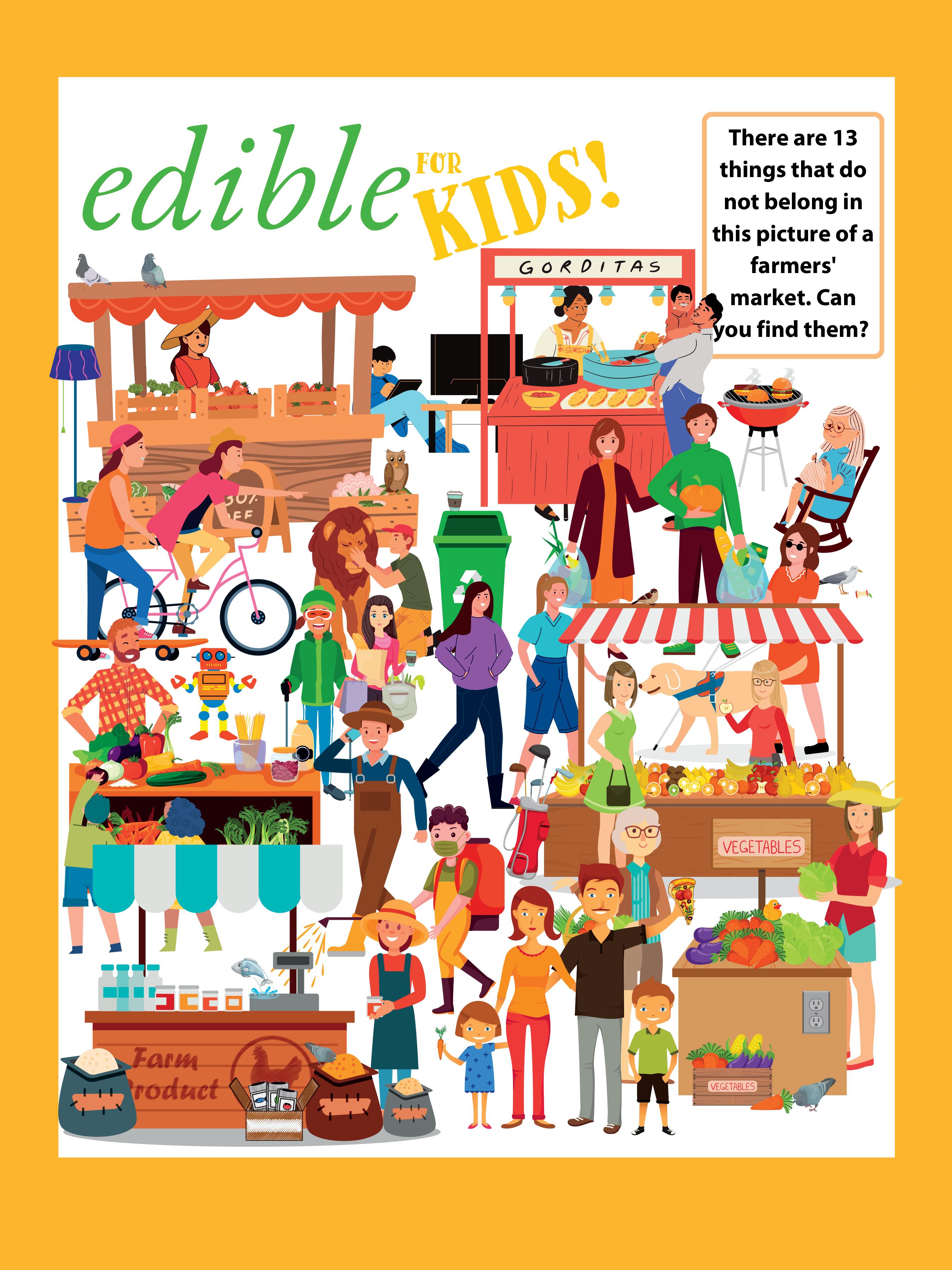San Fernando Valley



Get fresh updates on our work to ensure the future of agriculture includes all Americans.
farmland.org

Discrimination against marginalized groups in agriculture negatively affects all Americans by limiting the opportunities for farmers, workers, and consumers.

AFT is raising up diverse voices in agriculture, because we believe diversity contributes to a more resilient agricultural system, a stronger economy, and a more equitable society.
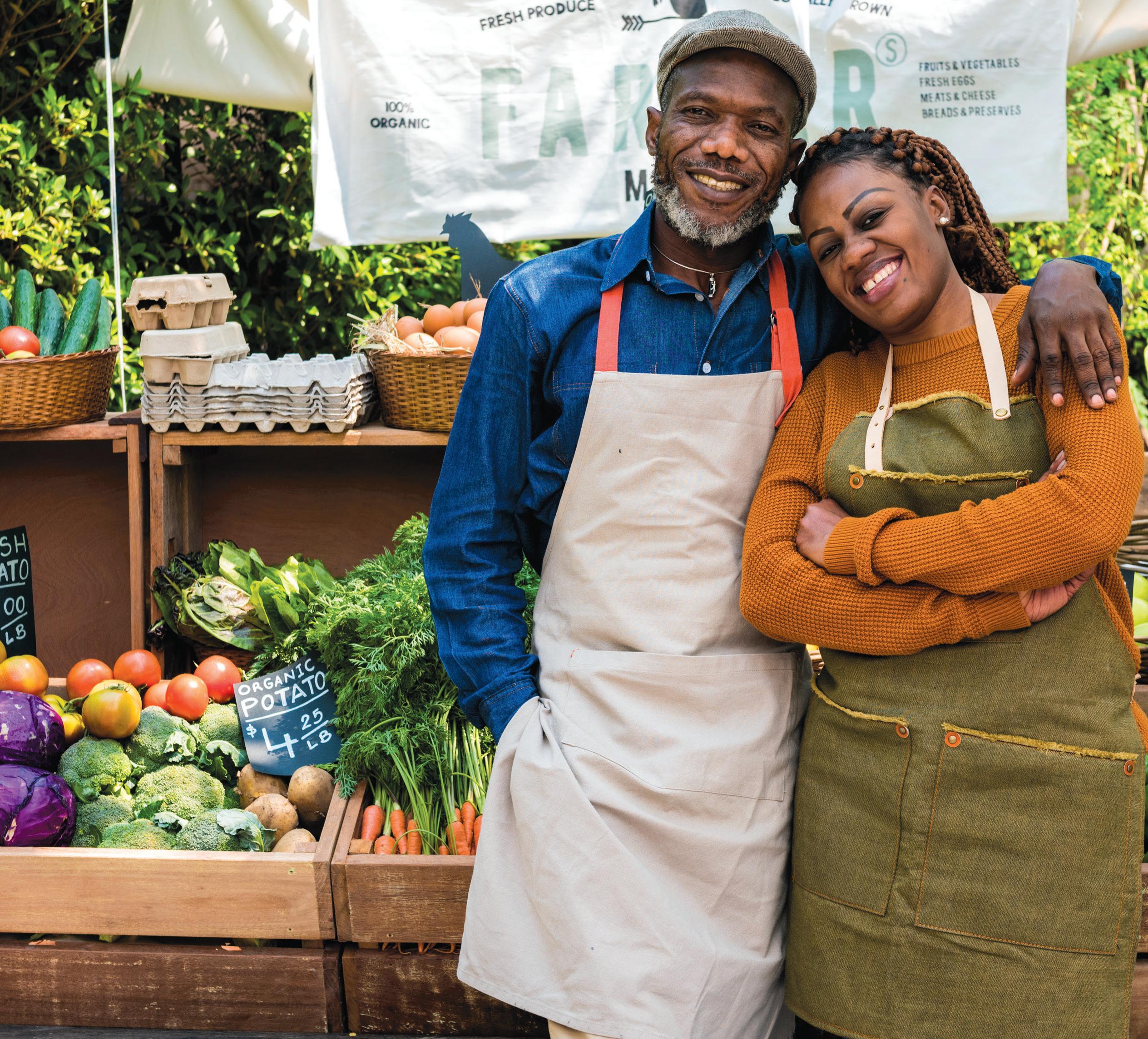
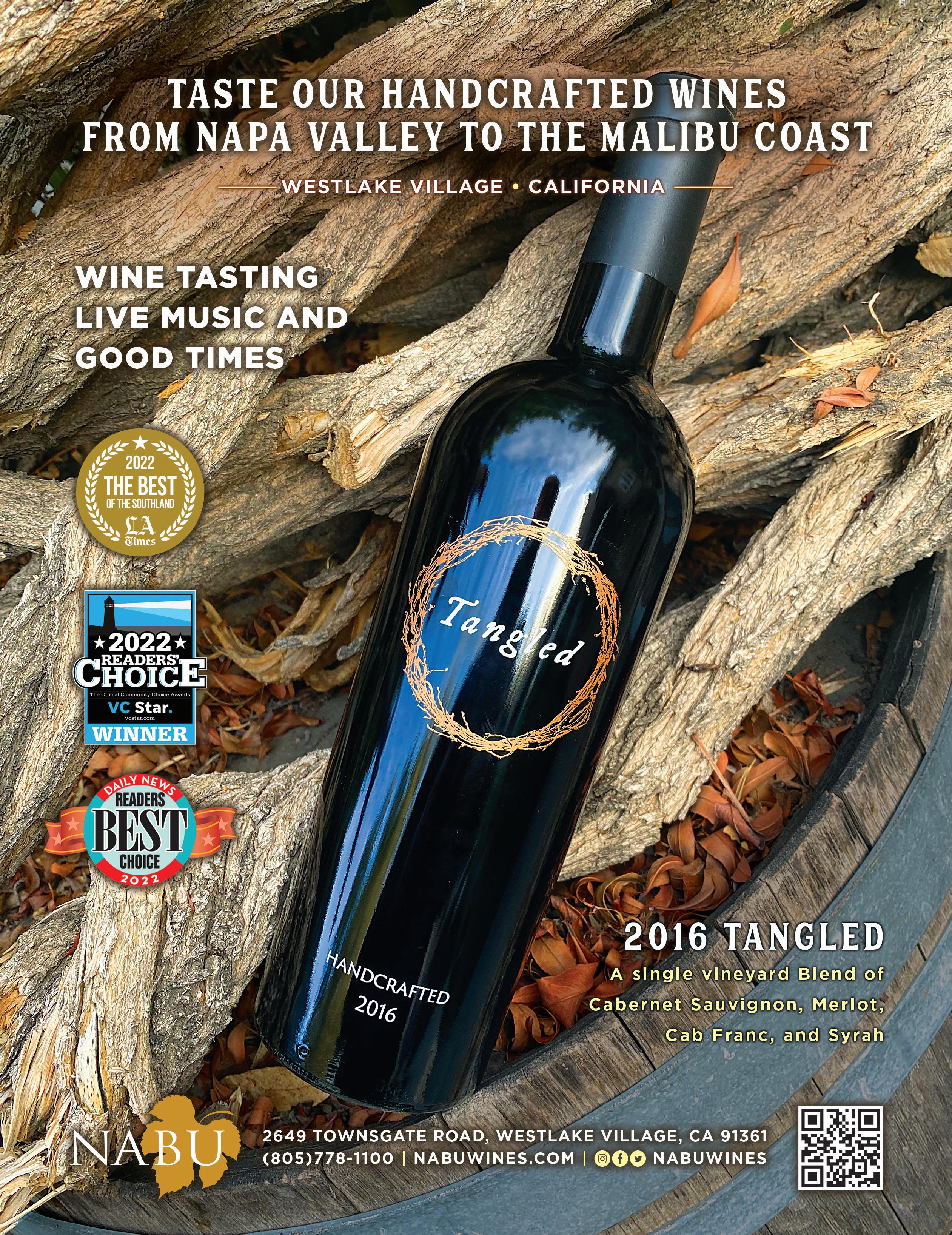 RICHARDSON
RICHARDSON
Edible mushrooms have made quite the resurgence in local cuisine. Find out who is growing them locally in our story on page 20, and where else you might find them on pages 36 and 38. Photo of Fungi Valley fungi in baskets at the Atwater Village farmers’ market by Carolina Korman.











Winter in our part of Southern California might not bring snow, but it certainly keeps us on our toes. One week, we cavort at the beaches with temperatures more suited to late spring, (happy holidays?), and the next, the Atmospheric River swings by for a cool breezy visit.
Historically, winter is a quieter, slower season. A time when the crops have been collected and preserved, the nights are long and nature is outwardly resting, preparing for the resurgence of spring. Nowadays, our busy lives don’t give us much of a chance to step into the quiet rhythm of the natural world, so we must do so with intention and purpose, finding some sort of balance that allows us to walk in both worlds.
As we jump into the second issue of this publication—not to mention beginning a brand-new year— I’ve been thinking a lot about what that balance of city life and nature looks like in the urban wonderland that is the Valley. Maybe it looks like creating an oasis of plants and trees and bird baths and feeders in your backyard or patio. Maybe it is carving out time to hike the nearby hills or walk in our many park reserves. Maybe it is focusing on seasonal foods and getting creative in the kitchen.
For me, sometimes it looks like taking my coffee outside in the morning or savoring the evening outdoors with the moon and my glass of wine. It looks like meeting at the nearby park to work out instead of going to the gym. Once in a while, it looks like taking the long way so that I can gawk at the ocean like a tourist. And this year, I am determined that it will look like making sure seasonal foods grace at least half my plate each day.
Whatever it looks like to you (and I am very interested to hear what that might be), it is my goal that we at Edible help you find easier ways to get there. With that intention, in this issue, we are including tips to sneak nutrient-dense vegetables into comfort foods (see page 18); ideas to make the most of your farmers’ market visits (page 36); and recipes to bring the season to your plate (page 12), just to name a few.
I hope that the stories we share inspire you to discover new pathways to balance and community. I know they do for me.

Until next season, happy eating!
OUR MISSION: Currently in its first year, Edible San Fernando Valley has been founded to document and bring to life the interest in farm-to-table, organic and natural foods, and to acknowledge the people and communities who feed and sustain us. We want to inspire readers to support and celebrate the growers, producers, chefs, food and beverage artisans and other food professionals in our community.

San Fernando Valley
PUBLISHER & EDITOR

Tami Chu
COPY EDITOR Doug Adrianson
DESIGN Cheryl Angelina Koehler

CONTRIBUTORS
Molly Chester • Tami Chu
Erin Davy • Nicole Faccuito Anne Kallas • Jennifer Richardson • Emma Roberts Jess Starwood
PHOTOGRAPHERS

Viktor Budnik • Tami Chu Carolina Korman Jess Starwood
ILLUSTRATORS

Ramiah Chu SALES
Mary DiCesare mary@edibleventuracounty.com Eric Hargrove eric@ediblesfvalley.com
SUBSCRIPTIONS
EdibleSanFernandoValley.com info@ediblesfvalley.com

CONTACT US
Publisher and EditorEdible San Fernando Valley 2470 Stearns St. #142 Simi Valley, CA 93063 805-622-9355 info@ediblesfvalley.com
Edible San Fernando Valley is published seasonally, four times a year. We are an advertising- and subscriber-supported publication, locally and independently owned and operated and a member of Edible Communities, Inc. Distribution is throughout Ventura County and by subscription for $28 per year. Every effort is made to avoid errors, misspellings and omissions. If, however, an error comes to your attention, please accept our sincere apologies and let us know. No part of this publication may be used without written permission of the publisher. © 2023. All rights reserved.
Edible San Fernando Valley
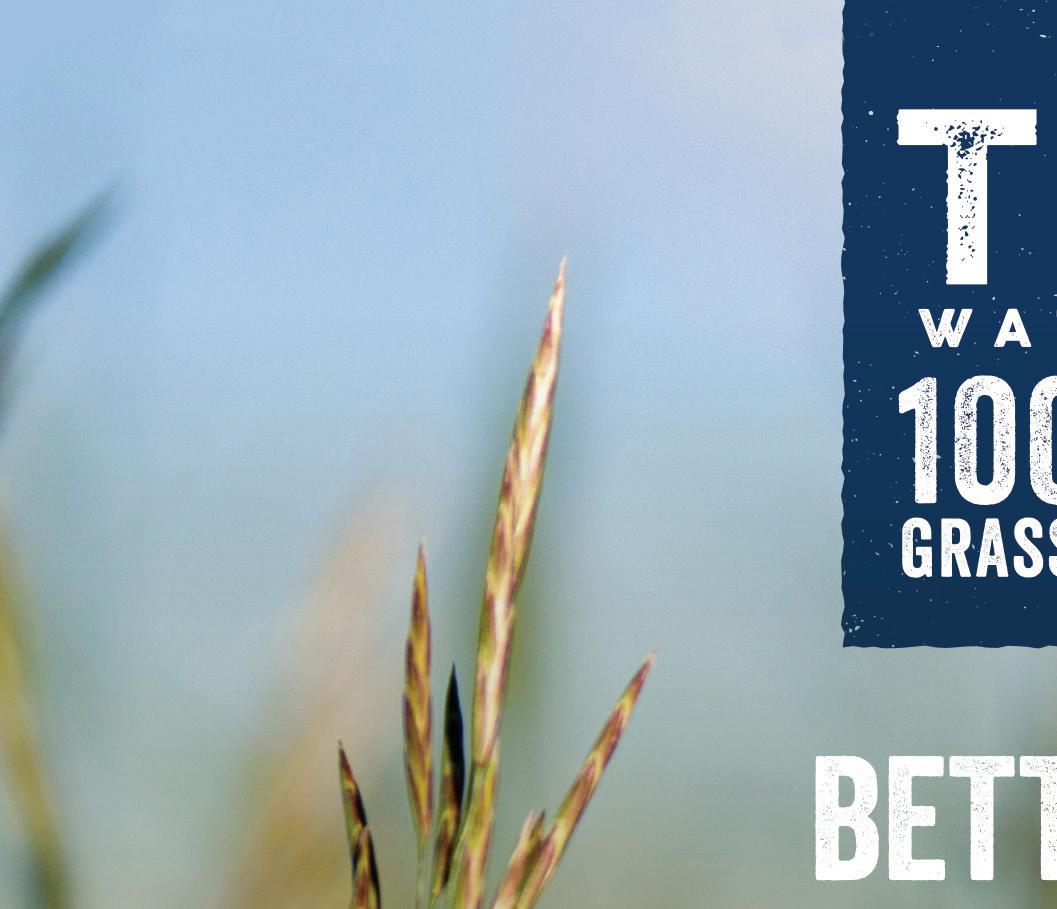
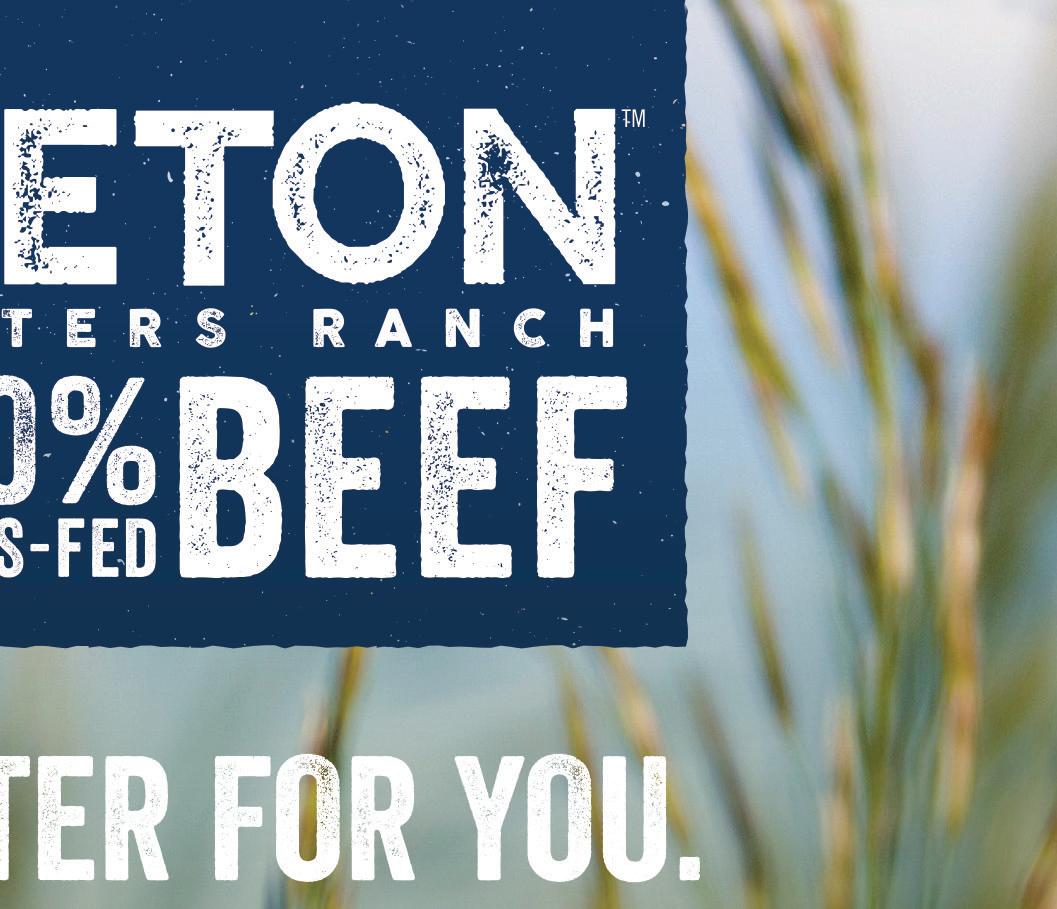








Atasty gluten-free bagel? There could be no such thing, according to most discerning food-lovers. It’s just not possible. Unless you visit Modern Bread and Bagel in Woodland Hills, where pastry chef Orly Gottesman has created versions of many popular baked goods without wheat, but full of flavor.
The years-long search for a tasty alternative for gluten, which is found in almost all baked goods as well as in other foods, has led Gottesman of Englewood, NJ, and husband Joshua Borenstein of Scottsdale, AZ, down a path that has brought them to the West Coast, where they recently opened their latest gluten-free and kosher bakery and restaurant.
Modern Bread and Bagel has joined other restaurants at Westfield Topanga & The Village, having opened less than a year ago in the destination shopping center.
Borenstein explained that he has been working with Westfield Corp., a shopping center development and operations manager. After the enthusiastic opening of Modern Bread and Bagel on the Upper West Side of New York City, where bagel quality is almost sacred to some, the couple started expanding by opening another NYC restaurant in Chelsea.

“We wanted to know whether our success may have been due to the local clientele. We were keen to explore other areas that look like other parts of America and have more of a mixed audience,” says Borenstein, adding that the outdoor setting is very welcoming and the other merchants make business promising.
The couple met at New York University, and married in 2010. Borenstein had been diagnosed with celiac disease as a 20-yearold college student, and when the couple moved to Paris for Borenstein’s job, it was especially hard to pass by some of the best pastries in the world. So Gottesman spent her free time exploring patisseries and learning about the art of baking, which ignited a passion.
When the couple were reassigned to Sydney, Australia, Gottesman continued her quest to create a palatable alternative for gluten. She undertook patisserie training at the Le Cordon Bleu Culinary Arts Institute in Sydney.
“There, I was given a test kitchen play around with every gluten-free ingredient under the sun. My assignment was to make everything in class, but gluten free. Ultimately my work was published in the curriculum,” Gottesman says.
The key to making substitutions for gluten, she found, was to make different blends for different uses. “I ended up using different blends of flours for cakes vs. breads vs. pastries. I launched a Blends by Orly business where people can buy the blends [in stores and online] for their own baking,” says Gottesman, who uses such ingredients as quinoa, sorghum, millet and brown rice to create the best results possible.
Along the way, they grew their family to include three children: a 6-year-old son, 3-year-old daughter and a 7-month-old daughter. Gottesman says balancing her businesses with mothering tiny people is hard. But her mom lives around the corner and regularly helps out. And, of course, so does Borenstein.
The couple decided to take their hard-won knowledge and open a bagel shop and eatery in New York. “We wanted to be the best gluten-free bagel around,” Borenstein says, “which was a very low bar.”
Apparently others have agreed that Modern Bagels are indeed delicious. They were listed among the best bagels in New York City by Eater NY, among other accolades.
In addition to offering bagels even gluten-lovers gobble up, Modern Bread and Bagel offers a wide variety of sides, including cream cheeses—featuring the in-house smoked salmon bagel blend, and other tasty noshes that pair perfectly in their sandwiches. They also offer breakfast and lunches, including deli salads, bowls and sweet brunch items—all 100% gluten-free and kosher.
Looking for a New York bagel without the gluten? Pastry chef Orly Gottesman and husband Joshua Borestein (pictured with their children) have brought New York to Woodland Hills with their new 100% gluten-free bakery.
Modern Bread and Bagel 6256 Topanga Canyon Blvd., Unit #1200 Woodland Hills 818-474-4171
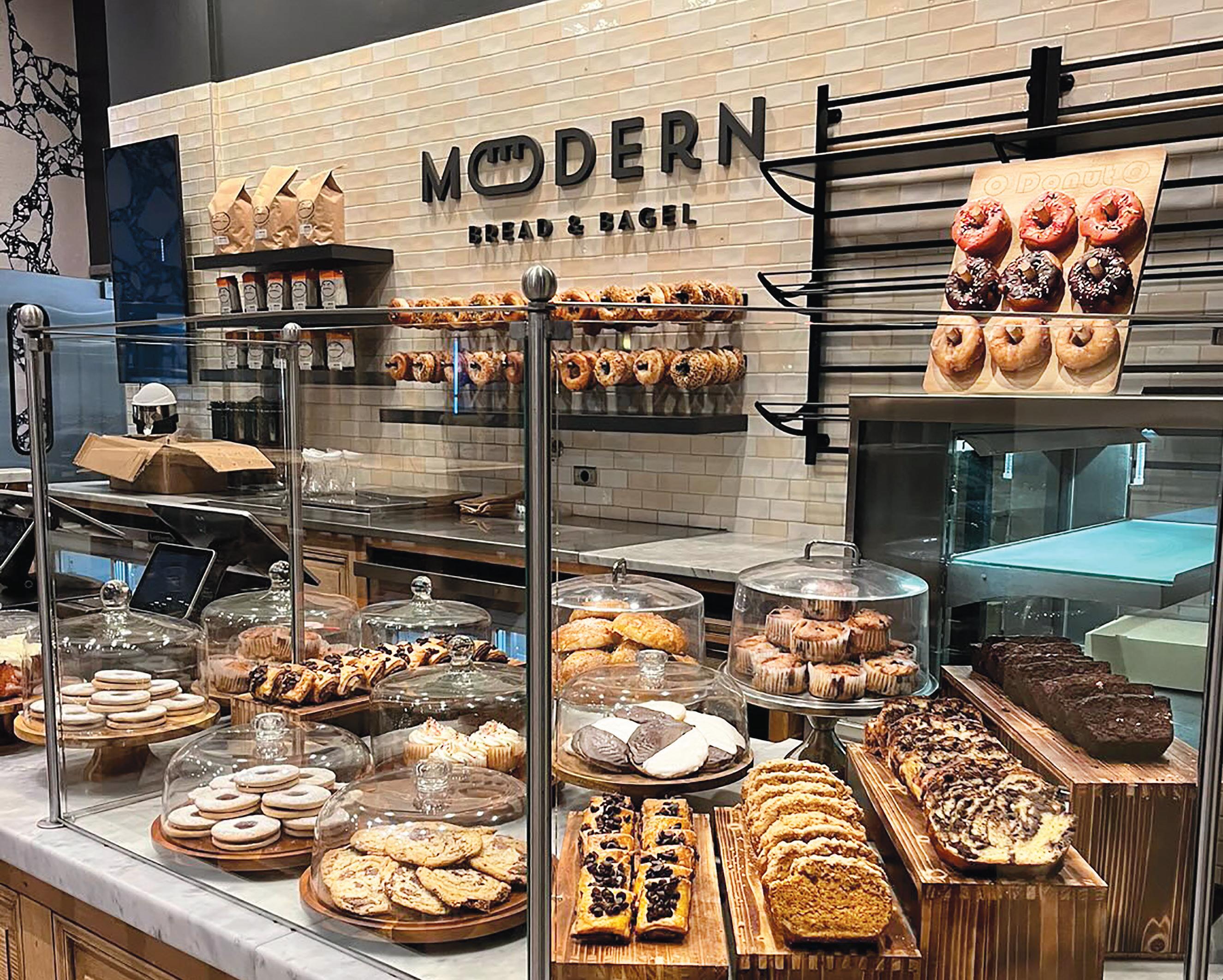
ModernBreadAndBagel.com
Anne Kallas is a prolific freelance writer focusing on Ventura County and the San Fernando Valley. A fan of local, seasonal produce, she lives in Ventura and is a former columnist, writer and copy editor for the Ventura County Star
Whether it’s making music or baking bread, Randall Michael Tobin likes to riff. He finds that allowing spontaneity to weave a path through a problem can produce great results. Those results are now available at Random Acts of Breadness in Burbank, where a special mix of flour is used to create a healthy long-fermented sourdough bread.

“I am a producer, composer, songwriter, engineer and orchestrator, but I’m always looking for creative challenges,” says Tobin. When one of his great friends, artist and film producer David Tourjé, had a heart attack in 2017, Tobin started to apply his food research to creating healthy culinary choices. Tourjé is founder of the Chouinard Foundation in South Pasadena, a center for contemporary artists.
“Dave survived his heart attack, and while recuperating discovered Dr. Steven Gundry’s book The Plant Paradox and introduced it to me,” says Tobin. Gundry postulates that foods high in lectins can cause harm to the body, promoting obesity, chronic inflammation and auto immune diseases. A long-time student of “food as medicine” health, this resonated with Tobin.
Tobin says his sourdoughs are made of specially refined flour to limit lectins, while creating a light, flavorful bread.
“Sourdough bread, the way it’s made in Europe—especially France and Italy—is made from organic flours without the bran or germ. This is unbleached white bread flour consisting of wheat and malted barley,” says Tobin, who also uses a light rye flour. Once the bread recipe and process had been nailed down, Tobin and his wife, Cyndie Tobin, started delivering loaves of bread to friends and acquaintances as “random acts of breadness.” People were clamoring for more, but the Tobins didn’t have the necessary facilities to bake commercially.
Their family friend, Tourjé, who was one of the first to try the bread, kept nagging the couple to find a place to permanently establish a restaurant.

“He was just giving stuff away,” Tourjé says. “I was, like, ‘Dude, you need to make money.’” He started scouting various locations, which were rejected by the Tobins, who wanted to keep the shop close by their home in Burbank. When an ice cream and pie shop closed two
miles from their home, the Tobins felt fate was calling.
“There must have been angels on my shoulders,” Tobin thought upon spying the workspace, which was already laid out as a bakery and could be easily reconfigured for his purposes.
Tobin said that while baking bread to give away was fulfilling, he wondered if total strangers would be willing to pay for it. So he jumped in with both feet. “When we sold out in two hours on opening day, and in an hour and a half the next day, I knew we were onto something special,” he says.
Tourjé says the popularity of the bread comes from its quality, “It’s very wellmade bread. From the culture he starts with to the flour, everything is super top-of-the-line. Of course he uses superb bread flour. People get addicted,” says Tourjé. “It’s all about creativity. Whether it’s music or baking, Randall Tobin has that creativity.”
In addition to bread, Random Acts of Breadness sells a line of raw butters, coconut-oil-based spreads, honey spreads, tapenades and jams. The bakery also has an extensive line of Ojai Olive Company oils and balsamic vinegars, all perfect for serving on special custom-made bread boards by local craftsmen. The idea is to create “Breadness Baskets” of baked goods and accoutrements that are suitable for gifting, because Tobin has big plans.
“People go to Starbucks for coffee because there is a following and a culture around it. We want to be the sourdough bread Starbucks,” he says.
Random Acts of Breadness 2214 W. Magnolia Blvd., Unit A Burbank
Order at Breadness.com or 818-562-7303
—that concept of fate or destiny—has been kind to Kismet—the restaurant and rotisserie shop—owned and operated by Sarah Hymanson and Sara Kramer.
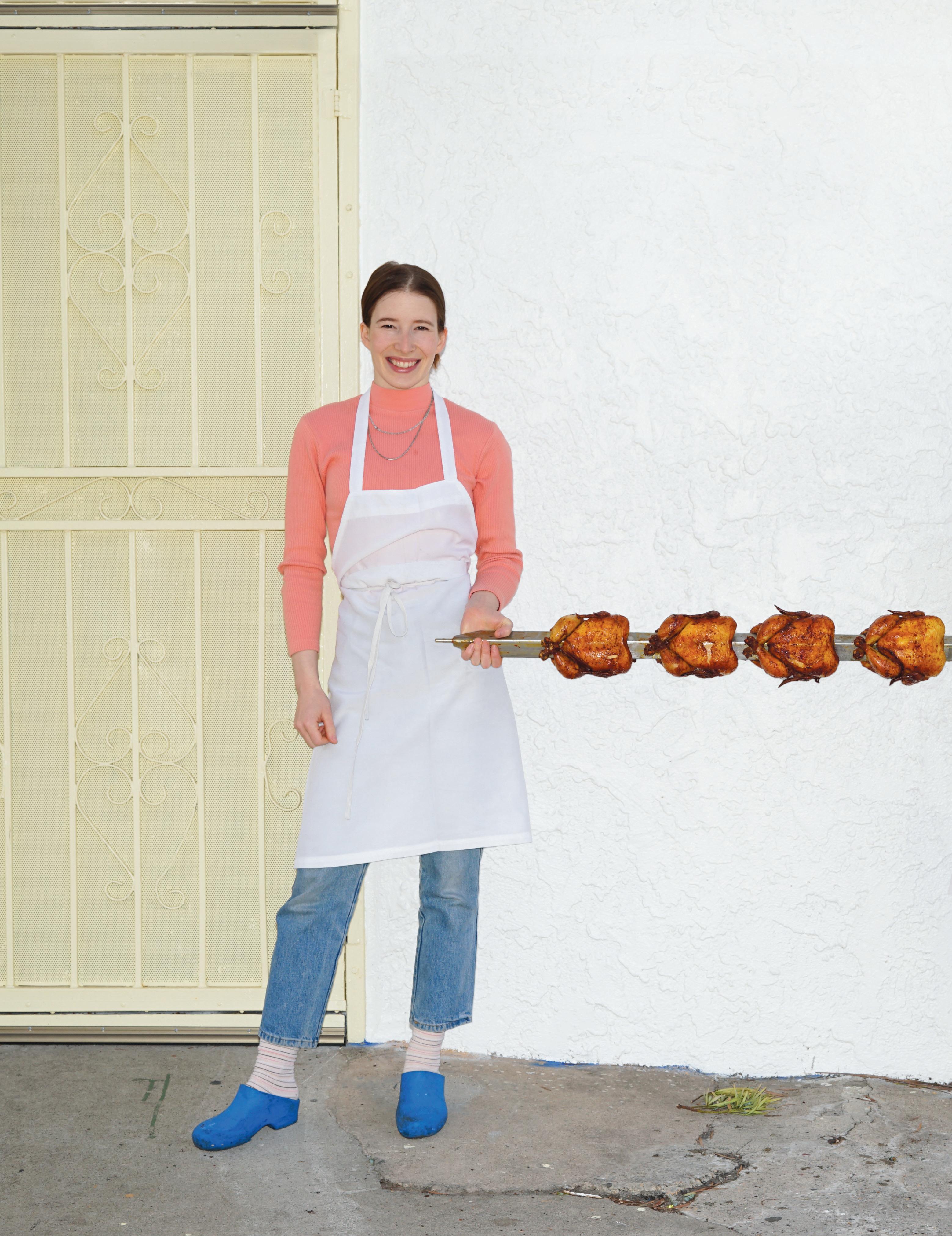
With glowing reviews from LA food writers—first for the somewhat casual sit-down dining of Kismet in Los Feliz, then for the elegant simplicity of the rotisserie—the two chefs have had nothing but a warm reception ever since moving to Los Angeles from New York City in 2014.
They’re counting on that enthusiastic response to their vision when they open their second Kismet Rotisserie in early 2023 in The Shops at Sportsmen’s Lodge in Studio City.
“I think people appreciated our fresh perspective: lots of vegetables presented playfully and thoughtfully in a bright and friendly environment. It never goes out of style,” says Hymanson. “I think, similarly, people appreciate rotisserie for its thoughtful and consistently delicious food. There is something for everyone there.”
Perhaps it’s that fresh approach to cooking that’s brought people in droves to Kismet, the restaurant, and then in 2018 to the first Kismet Rotisserie, which was opened in Los Feliz. Although the name and cuisine suggest roots in the Middle
East, Kramer balks at calling their food Middle Eastern because she says Kismet’s food doesn’t actually follow those traditional rules and flavorings.
“We’re using Middle Eastern (among other) ingredients and influences and serving Mediterranean-style chicken and vegetables,” says Kramer. “We look for bold, bright, freshest flavors. And without the chicken, the menu is entirely vegetarian.”
After first working together in the kitchen at Glasserie, a Mediterranean restaurant in Brooklyn, NY, the two decided to move to Los Angeles. They originally opened a falafel shop in the mid-2010s, which ultimately closed with the pandemic. Then they went into business with Jon Shook and Vinny Dotolo’s Joint Venture group in 2015 to establish Kismet, the restaurant, but split amicably to create Kismet Rotisserie in May 2021.
Sarah Hymanson (opposite) and Sara Kramer (below) have been making food together for a decade and seem to have found the magical combination that has resulted in their second Kismet Rotisserie, a neighborhood restaurant, opening soon in Studio City.
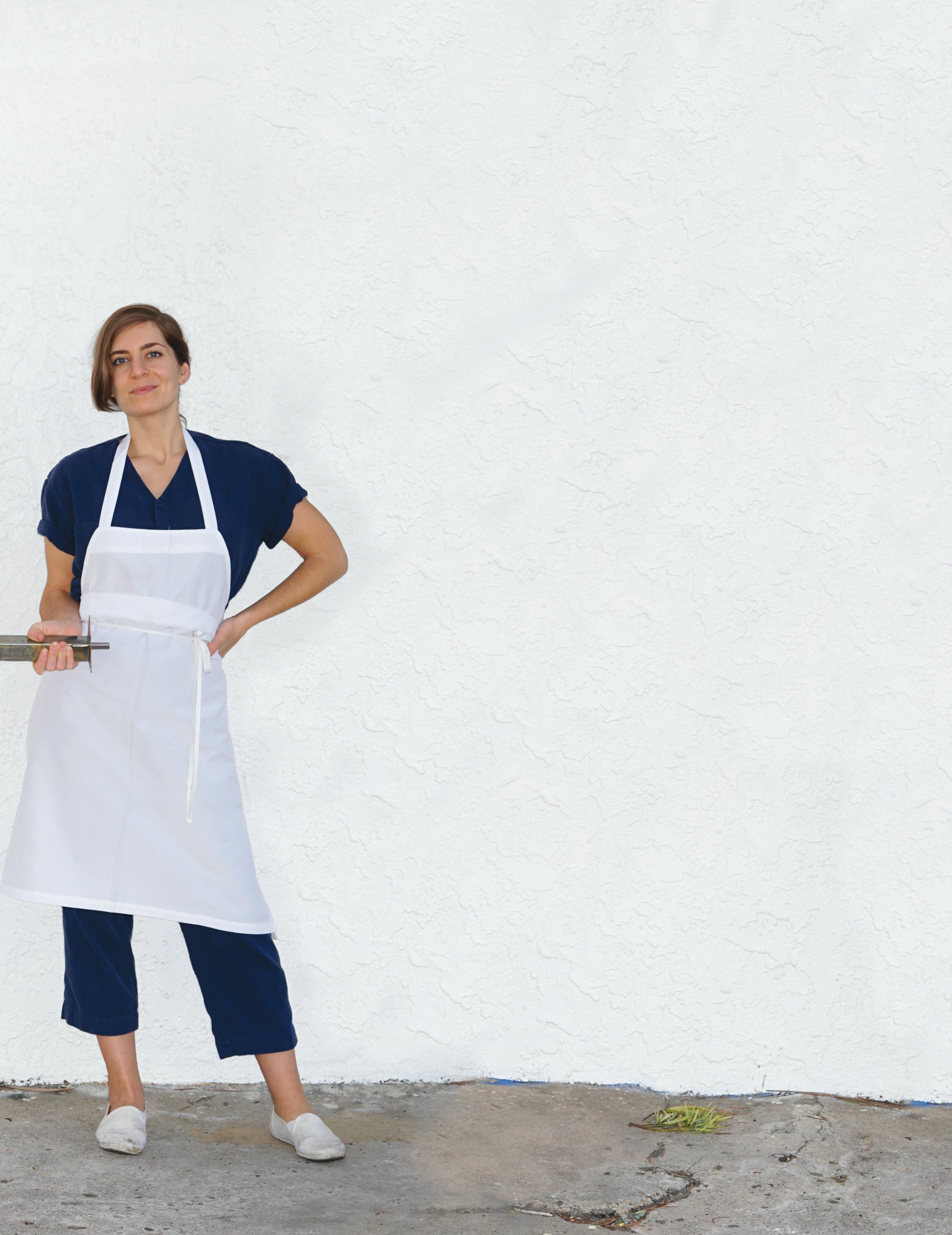
Now, nearly a decade into their partnership, the two chefs have created a synergy that emphasizes their strengths while delegating other tasks.
“After almost 10 years, we have figured out how to work together. We originally needed to figure out how to split our time responsibly. It’s divide and conquer. We each have our own little worlds we need to figure out,” says Kramer, adding that she focuses on administrative and front-of-store operations, among other things, while Hymanson focuses on kitchen operations.
“The key to our partnership is undoubtedly trust and a strong work ethic,” says Hymanson. “Our relationship requires attention and care; it is like any really intimate, long-lasting relationship. It is the commitment to working through things, the commitment to the relationship itself, that makes it successful and lasting.”
Kramer says they have decided to expand the Kismet Rotisserie concept, to see where it leads them.
“This is a part of LA where a lot of our audience has grown up and moved out to. We want to continue to service those people. The Valley is fun and cool,” says Kramer. “ [Kismet Rotisserie] is such a natural meeting point for Sarah and me. We want a place where you can have a hungry family with kids. There are hungry mouths to feed. We hope it is something that’s just a little bit more exciting than you can make at home.”
The biggest hurdle the two chefs faced was finding fresh, humanely raised chickens that could be produced in large enough volume for dedicated rotisseries.
“We put a bunch of chickens side by side. There was a wide range of flavors in the chickens. We wanted something that would really appeal to a wide audience,” Kramer says.
To keep a new supply of the freshest food possible, they have created a farmers’ market manager position, with someone who places orders with farmers at the Santa Monica and Hollywood farmers’ markets.
“They order in bulk in advance and we pick it up during the market,” says Kramer.
The Kismet menu features chicken, of course, with chili oil, garlic sauce, wedge salad and pita. Other ala carte options include sandwiches and salads, and spreads and sides, choosing among tahini, fennel tzatziki, peanut muhammara, pita, pickles and the chili oil or garlic sauce.
The sides are an exploration of the chefs’ taste profiles that they bring to their food, including wedge salad, with radish and miso poppy vinegar; couscous with tomato, sumac and dried mint; cauliflower with turmeric, cilantro and arugula; “schmaltzy potatoes,” which are fried up in chicken fat, naturally, or “veg” potatoes with garlic oil.
After Studio City, the next rotisserie is planned for Culver City.
“We would love to continue growing the Kismet restaurant group and are focused on the original and the rotisserie expansion for now,” Hymanson says.
In the meantime, it’s all about a tasty, flavorful meal. “We make consistently healthy and delicious food,” says Kramer. “It’s that meal you’re craving.”
Kismet Rotisserie
12833 Ventura Blvd Studio City
KismetRotisserie.com
Iadore walnuts. When people learn that I grew up on an organic walnut farm, the responses are always polarizing. People either love them or strongly dislike them and are often wary of this brain-shaped nut because of the flavor of the walnuts they are used to eating. If you’re accustomed to dry, bitter, unappealing walnuts, then you’ve probably been eating old nuts.
The flavor of walnuts has everything to do with seasonality and storage. Think about any seasonal fruit or vegetable you’ve ever had, and I’m sure you can remember the moment you realized how incredibly different it tasted when it was at its peak of freshness. Most people don’t give this type of consideration to walnuts, though they should.
Seasonal walnuts enjoyed within their harvest year have a wildly different flavor profile than what many are familiar with. They’re soft, buttery and utterly delicious.
Being raised on a farm, I was always working—from pruning suckers off the trees to helping my dad prepare for harvest. There’s no better experience than picking a walnut straight off the tree, smashing it against its trunk and enjoying it on the spot.
Unless you’ve had the good fortune of a walnut tree in your backyard or personally know a walnut farmer, acquiring a stash requires a bit of perseverance. An orchard’s bounty is typically harvested beginning around the fall equinox, so it’s best to keep an eye out at your local farmers’ markets during the winter months. A simple Google search for “seasonal raw organic walnuts near me” will help you find
them. Trust me: The effort will be worth it, and your relationship with walnuts will completely transform.
I’m sure some of you can relate to the experience of biting into an old, rancid walnut. It’s no fun. Walnuts contain roughly 50–70% oil, depending on the variety, and when this delicate liquid sunshine goes bad, no amount of soaking or roasting will help them taste any better.
Always look for and inquire about the harvest date when purchasing walnuts. We’re all familiar with expiration dates. However, that date won’t tell you how old the nuts are. The harvest date is a “must-know” when sourcing fresh walnuts that you can’t stop eating!
As someone with an abundance of fresh organic walnuts on hand, I’ve enjoyed them in every format imaginable: whole walnuts, walnut meal, walnut oil, walnut butter, walnut milk, pickled green walnuts and even a walnut liqueur. When added to chilis and curries, walnuts generate a lovely balance of tender flavor and crunchy goodness. On a whim I once added walnut cream to ramen broth, which completely transformed the dish. Believe it or not, walnut oil is an incredible addition to cocktails—a complete game changer. In their various forms, walnuts add an unexpected decadent touch to many dishes, and freshness is the key to their versatility.
It’s easy to enjoy this seasonal superfood in any creation you make. With some of the highest levels of antioxidants and omega-3 oils of any nut, these nutrient-dense gems will make a powerful addition to your culinary repertoire.

Walnuts are a versatile ingredient that can be used in an abundance of dishes. The recipes shared here are vegetarian and made with simple, seasonal ingredients that allow their fresh flavor profile to shine. When a recipe calls for walnuts, the key to a delicious outcome is to source the freshest, inseason walnuts possible to prevent old, rancid nuts from ruining your culinary creation.
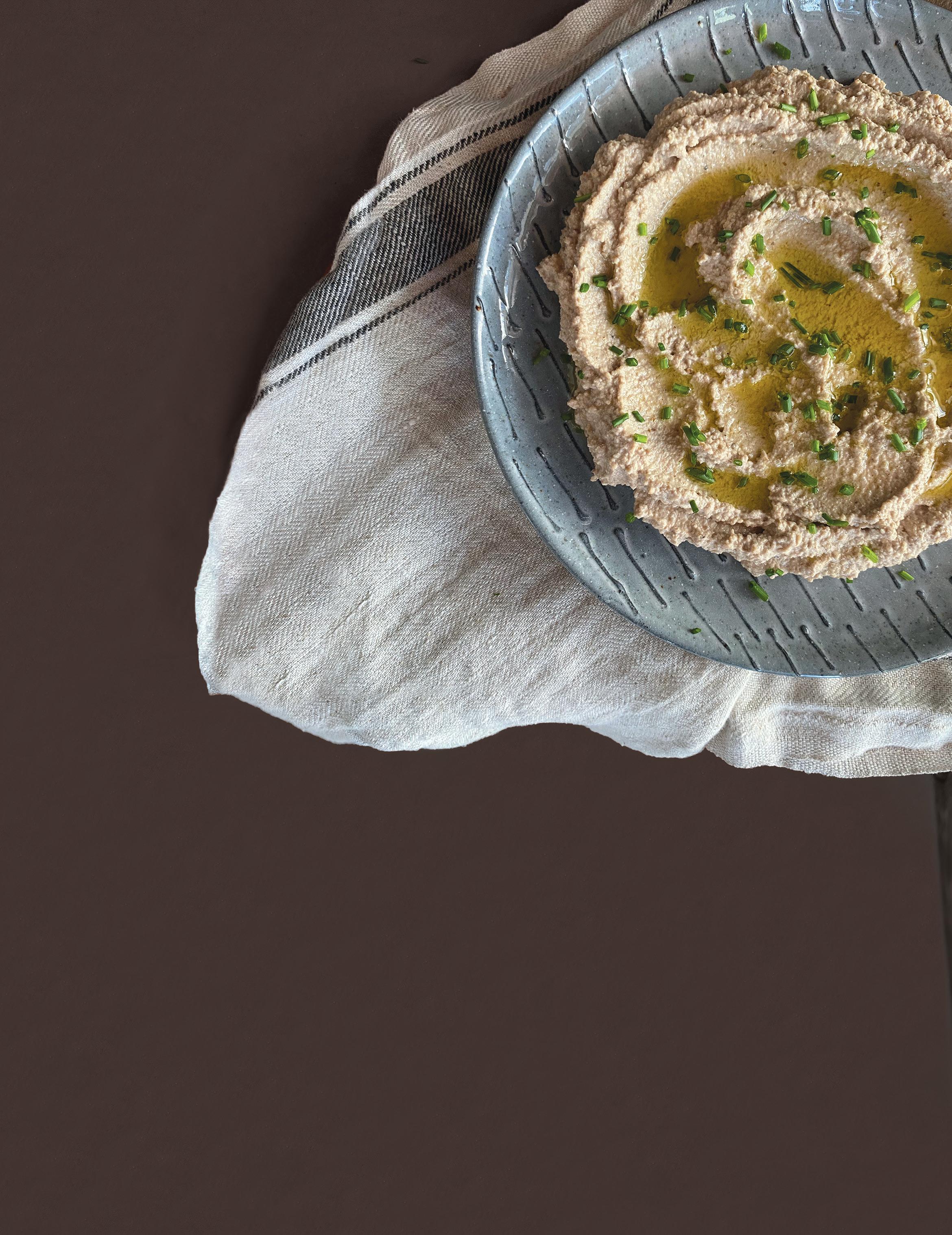
Watch out, dips of holiday past: There’s a new kid in town. We use our own fresh organic CORKY’S NUTS walnuts in almost everything we make, so adding this dip/pâté creation to our weekly snacking repertoire didn’t take long. As a versatile spread, it pairs beautifully with crudites and works wonders on a sandwich.
Makes about 2 cups
2 cups chopped walnuts
16 cloves raw organic garlic
½ cup water
¼ cup organic lemon juice (roughly 1 large lemon)
2 tablespoons nutritional yeast
2 tablespoons organic olive oil
1 tablespoon organic Bragg Liquid Aminos or organic tamari (soy sauce)
¼ teaspoon Himalayan sea salt ¼ teaspoon black pepper
Chopped organic chives for garnish
This can be made in a blender or food processor. Combine all ingredients and blend to creamy or desired consistency. Less blending yields chunkier texture.
Serve on a plate or bowl and finish with a drizzle of olive oil and fresh herbs.
Chef Notes: Pairs well with a charcuterie board, sliced raw veggies, chips and crackers. Can also be used to top a quinoa bowl with fresh mixed greens and vegetables.
Alternatively, you can add ¼ cup of seasonal chopped fresh herbs; stir in after blending and before plating. Don’t have chives on hand? Sprinkle on red pepper flakes or a za’atar blend.
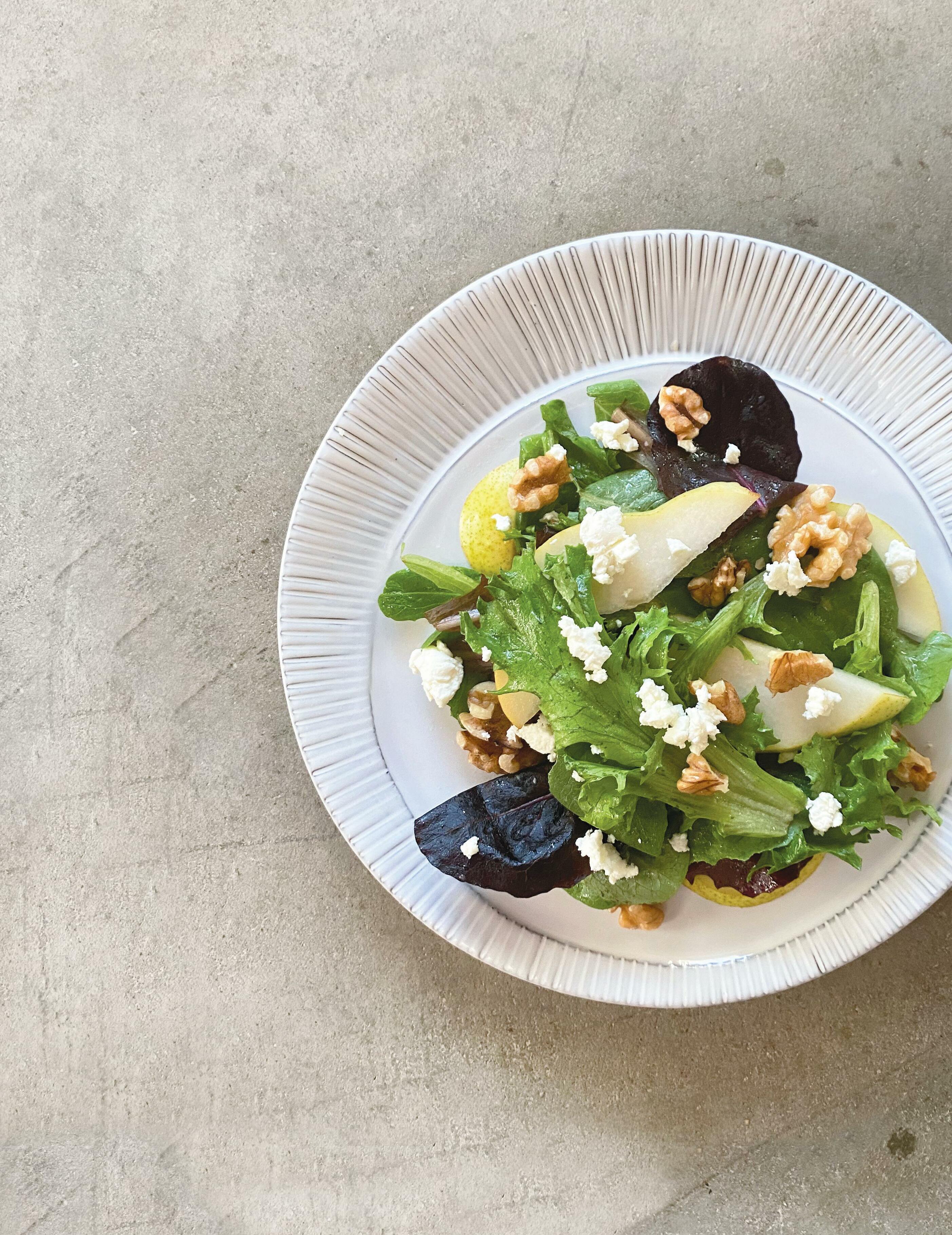
I love using walnut oil for dressings. Its mild, buttery flavor makes anything paired with it shine. This salad and dressing pay tribute to sweet and umami flavor profiles and deliver a delicious, whimsical journey for your taste buds.
Serves 2 as a main dish, 4 as a side dish
For walnut miso dressing:
3 tablespoons cold-pressed organic walnut oil
2 tablespoons white wine vinegar
1 teaspoon white miso paste
1½ teaspoons maple syrup
Pinch of salt and pepper to taste
For salad:
1 Bartlett pear
8 ounces seasonal mixed greens
2–3 ounces plain goat cheese
½ cup raw organic walnuts, whole or chopped
Combine walnut oil, vinegar, miso, maple syrup, salt and pepper in vessel of your choosing. Either seal and shake, or mix with whisk/fork until blended.
Slice pear in half lengthwise, then slice into thin segments; set aside. Add mixed greens to a bowl and pour dressing over greens. Gently toss until greens are thoroughly coated. Transfer greens to serving bowl or platter. Add sliced pears to salad. Garnish with goat cheese and whole or chopped walnuts. Serve immediately.
Chef Note: The fruit element in this salad can be adjusted depending on the season: citrus in late winter, blueberries in the spring, strawberries in summer, pears or pomegranates in fall. Looking to add a protein element? Grilled chicken or shrimp would make a lovely addition.
This rich, creamy soup takes advantage of one of winter’s prolific edible bounties: squash. In all its various flavors and shapes, using this simple ingredient to warm you on a rare chilly California day will delight your palate with seasonal goodness.

Serves 6–8
1 large acorn squash 1 large delicata squash
Olive oil 1 large yellow onion 16 cloves garlic 3 cups vegetable broth 3 cups raw organic walnuts 3 cups water
Salt and pepper
Fresh herbs (sage, chives, etc.)
Preheat oven to 400°F.
Line baking sheet with parchment paper. Cut each squash in half, remove seeds, drizzle a little bit of olive oil on each slice, place face down on baking sheet; bake on middle rack of oven for 45 minutes, or until tender.
While squash is roasting, roughly chop yellow onion and garlic. Add onion and garlic to a saucepan with a drizzle of olive oil. Cook on medium heat until onion is translucent, being careful not to caramelize. Set aside.
Remove roasted squash when soft to touch; let cool. Scoop out acorn squash and place in blender. For delicata squash, the peel is edible and gives a lovely color variance to soup. Cut delicata into smaller chunks and add to blender with acorn squash. Add 2 cups of vegetable broth and blend until smooth, adding more broth as needed until a smooth consistency is achieved. Once mixture is blended, place soup mixture in large saucepan or pot on the lowest heat setting.
Rinse blender in preparation for walnut cream.
For walnut cream:
Add walnuts, cooked onion and garlic and 3 cups of water to blender. Blend until creamy and smooth, roughly 2 minutes, depending on blender. Add salt and pepper to taste. Portion out half of the mixture and set aside. Pour the remaining walnut cream mixture into saucepan with soup base. Stir to combine. Add salt and pepper to taste. Slightly increase temperature and warm soup to serving temperature. This step is only in preparation for serving, no additional cooking is needed. If soup begins to thicken, add a little more vegetable broth. To serve, ladle soup into bowls and garnish with a dollop of walnut cream, salt/pepper and fresh herbs.
Chef Note: Don’t have vegetable broth on hand? A chicken or beef broth will also work.
These delightful truffles are easy to prepare days ahead of a gathering and the perfect not-too-sweet snack to have on hand when that sugar craving kicks in. Think of them as an elevated, healthy version of a peanut butter cup. With just the right amount of sweetness, balanced with a little sea salt and packed with antioxidants, they’ll disappear quickly and provide a nutritious end to any event.
Makes about 28 truffles
For the truffle mixture: 6 organic dates
3 cups organic walnuts, chopped ¾ teaspoon organic vanilla extract
½ teaspoon Himalayan sea salt ½ teaspoon organic coconut oil
For the chocolate coating: 1½ cup dark chocolate chips (We used Santa Barbara Chocolate, in Ventura.)
2 teaspoons organic coconut oil
Pinch of sea salt
Toothpicks
Sea salt flakes to garnish. Can also use crushed walnuts or shredded coconut.
For the truffle: Add dates to small bowl and pour over hot water. Let dates soak 10 minutes, until soft.
To food processor, add chopped walnuts, soaked dates, vanilla, salt and coconut oil. Blend for roughly 1 minute, until smooth. Smaller chunks of walnuts are OK. Be mindful of over-blending, as you run the risk of more oil released from walnuts, which will not set properly.
Once blended, add truffle mixture to a medium-sized bowl.
Line baking sheet with parchment paper. Using a teaspoon, portion out truffle mixture to make 1-inch balls. Roll mixture between hands and place each ball on lined baking sheet. Continue until all mixture is used.

Place truffles in freezer for 1 hour to set before beginning chocolate coating.
For chocolate coating: Add dark chocolate chips, coconut oil and a pinch of salt to a shallow heat-safe bowl using a double broiler method: Bring 2 cups of water to a boil in medium saucepan. Place bowl with chocolate atop saucepan to melt ingredients, stirring consistently with a spatula.
(Alternatively, add ingredients to a glass bowl and microwave for 10-second intervals until completely melted, stirring in between.)
After chocolate is melted, remove truffles from freezer.
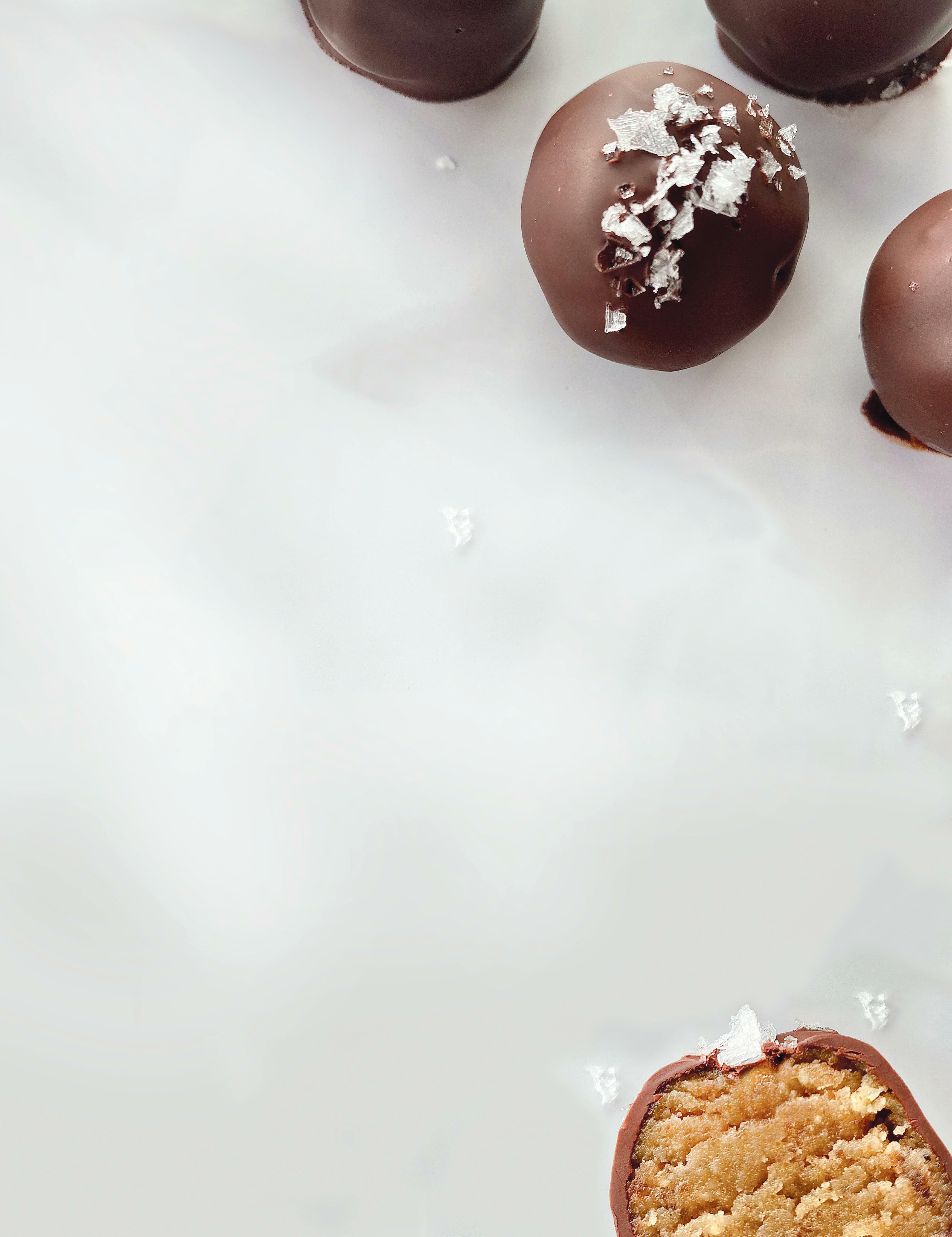
Using a toothpick, pierce one truffle at the top to pick up. While holding, place truffle in chocolate and use a spoon to thoroughly coat ball. Drizzle and shake off excess chocolate. Set the covered truffle back onto the parchment paper and use a second toothpick to gently hold the truffle
Chef Notes:
down while you pull out the toothpick. A hole will be present once the toothpick is removed. Use the toothpick to gently push melted chocolate over the hole to cover. Let chocolate set for about 1 minute, then sprinkle flaky sea salt on top. Repeat until all truffles are coated.
If you notice that the uncoated truffles are starting to soften, place back in freezer for 10 minutes, or until firm, and continue the chocolate coating.
After all truffles are coated and garnished, place tray in the freezer to set for 1 hour. Enjoy immediately, or store them in a sealed container in the fridge for up to 2 weeks. If you need to layer them, a piece of parchment paper can be used to stack truffles in container. You can also make the truffle mixture ahead of time and store sealed in the freezer until the day of coating/serving.
• Not a chocolate fan? Roll them in crushed walnuts, coconut flakes or cacao powder.
• Maybe you don’t have dates on hand? Use 1½ tablespoons of maple syrup as a substitute.
Ojai Valley, San Fernando Valley and Heritage Valley were filled with walnut orchards before citrus groves were planted in favor of higher yields/income.
Walnut trees don’t need bees and are pollinated by air currents.
Walnuts are 100% vegan.
Walnuts should NEVER be stored in the pantry. Always keep them sealed in the fridge or freezer.

Walnuts are cholesterol-free, rich in polyphenols, magnesium and calcium— making them great for brain and heart health.
99% of walnuts produced in the United States are grown in California.
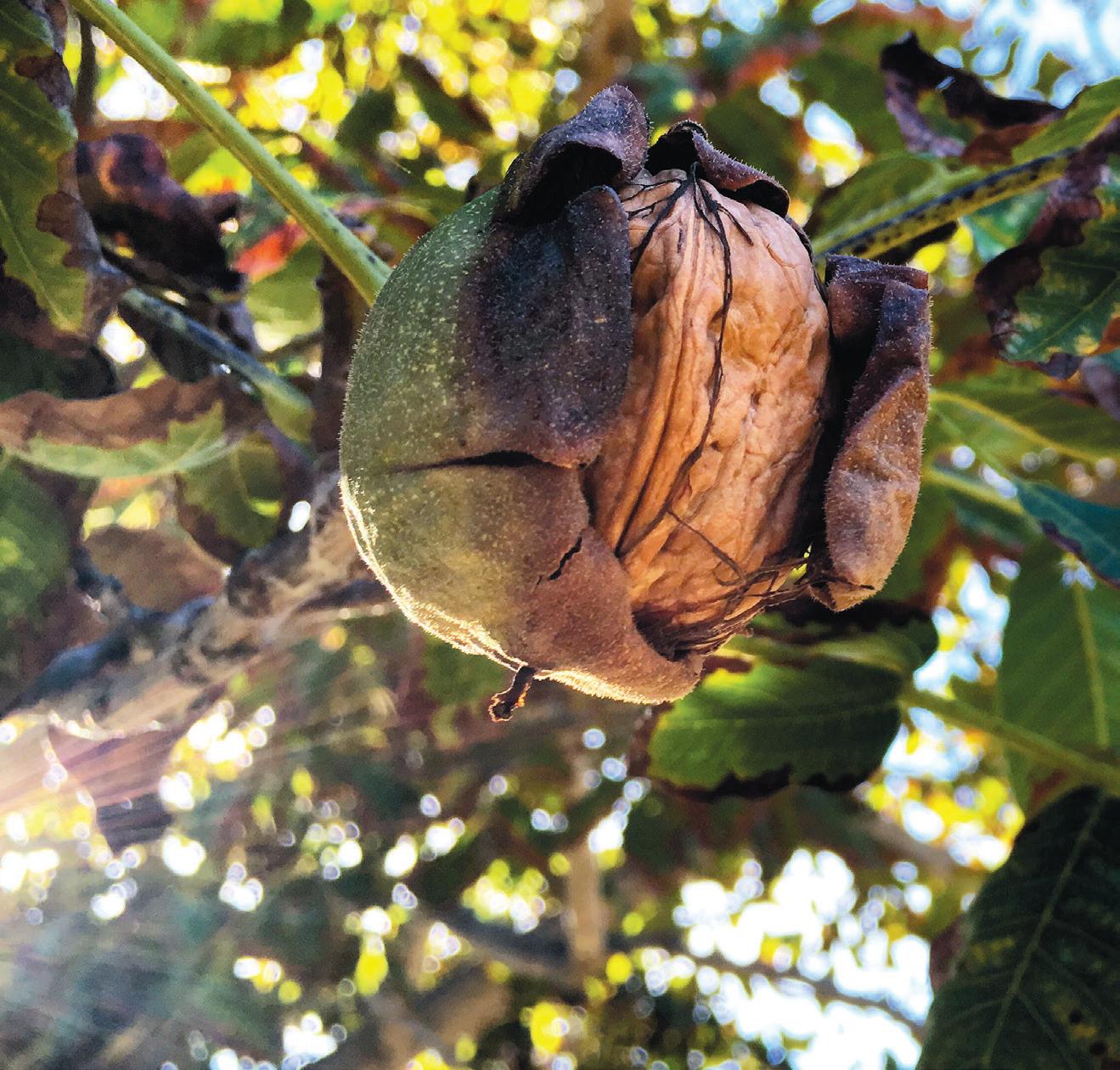
China is the largest producer of walnuts in the world. (Always look for the origin on the packaging.)
Best tip: Always look for, and inquire about the harvest year, not the expiration date.
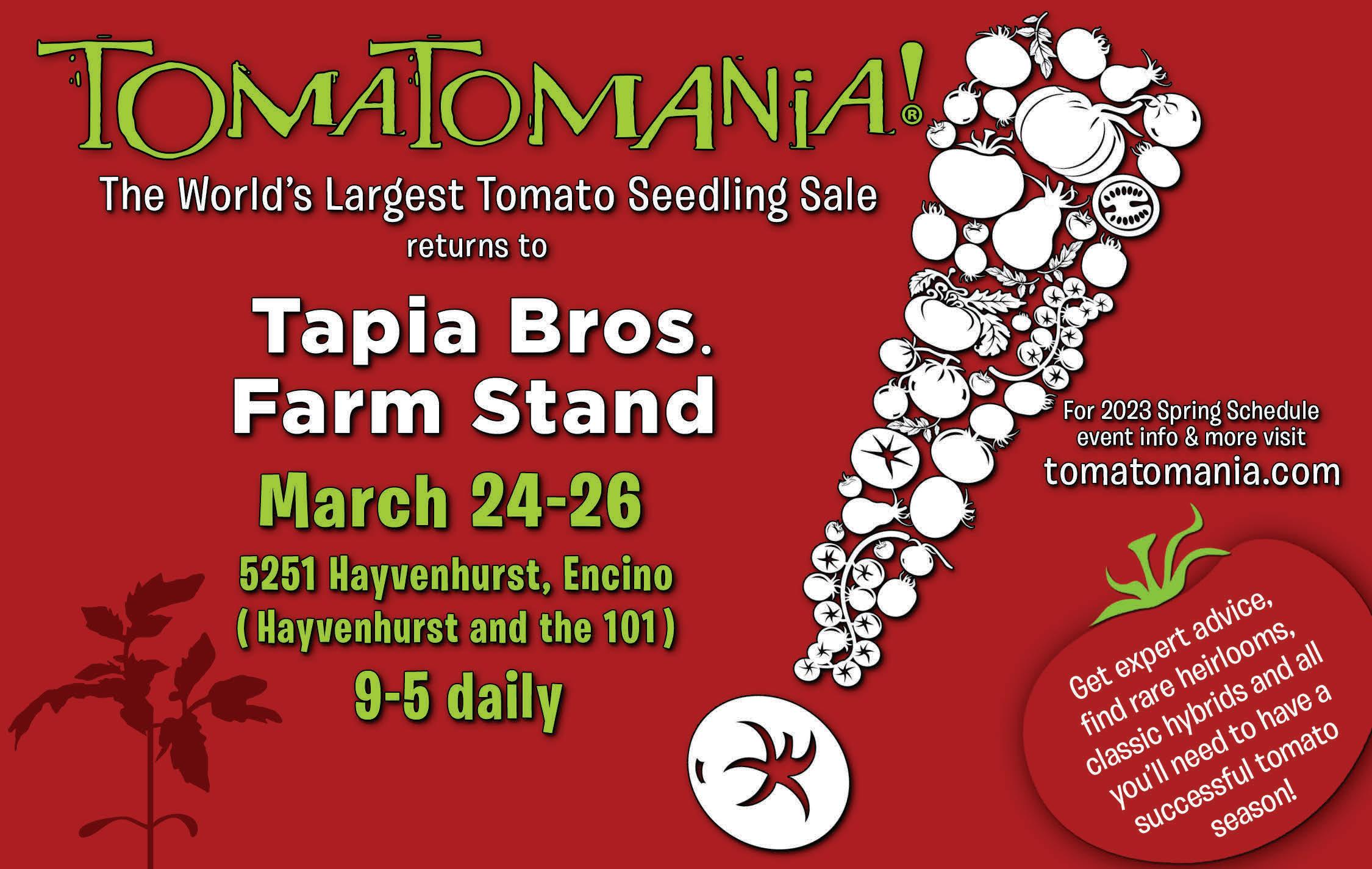




 BY TAMI CHU, MSHN
BY TAMI CHU, MSHN

• Add finely chopped kale, spinach or chard to mac ’n’ cheese or scalloped potatoes.
• Serve your pasta meals on a bed of mixed greens.
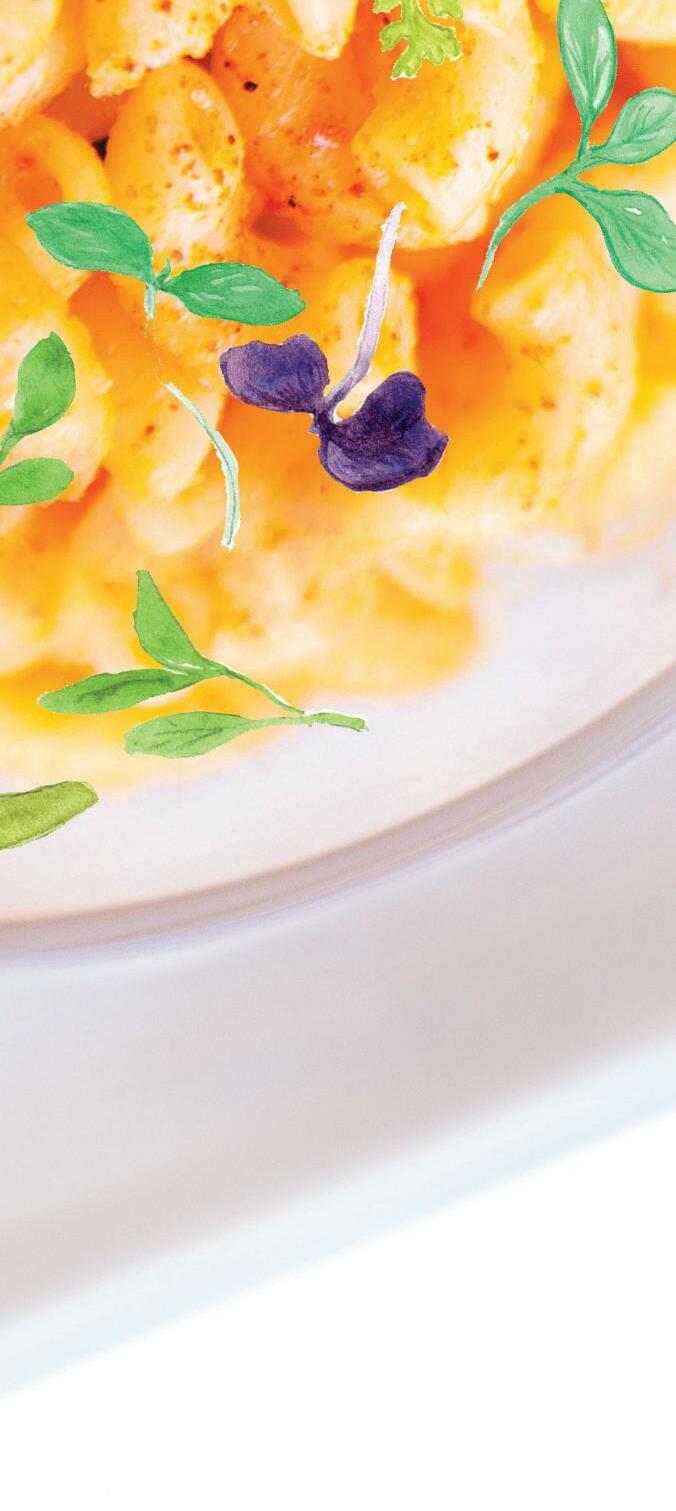
• Blanch or steam fresh veggies (carrots, greens, squash, turnips), purée and then add to your favorite pasta sauce. This works especially well in tomato-based sauces like marinara.

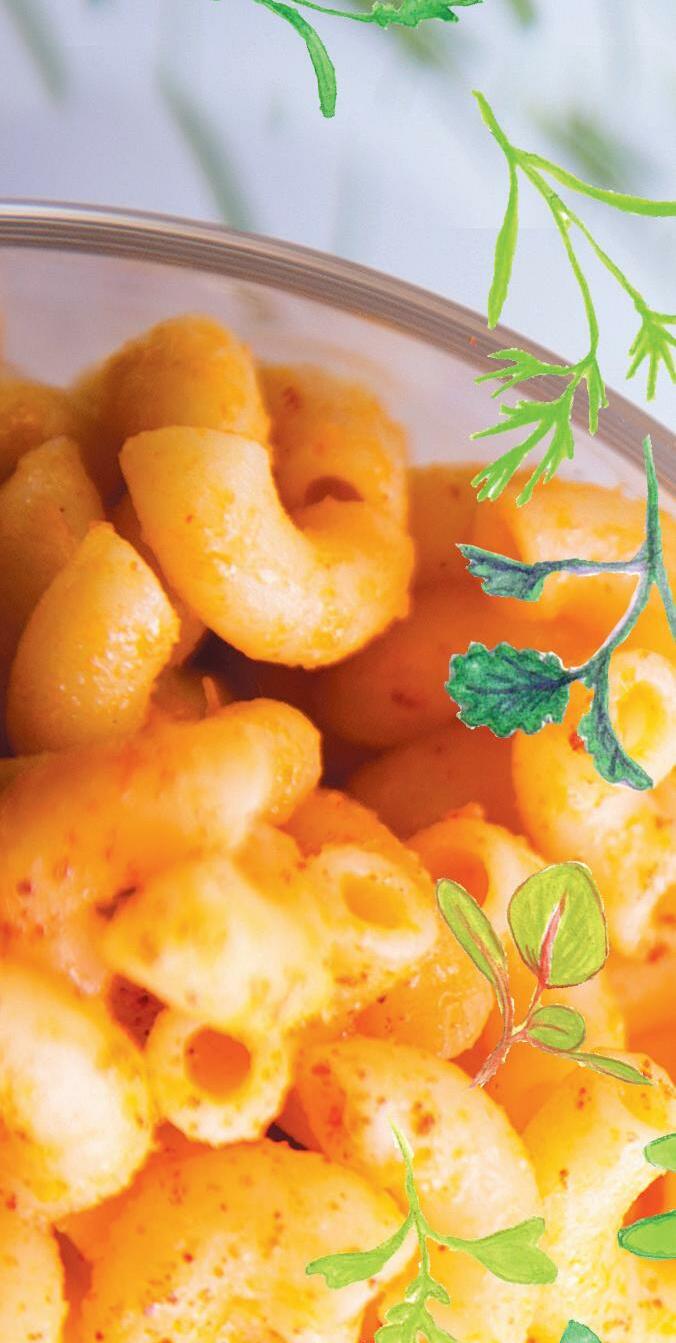
• Add blanched or raw greens to smoothies and blend well.

• Use cooked spaghetti squash, blanched zucchini or other winter squashes as noodles with your favorite pasta sauce. To hide them, you can mix them with traditional noodles.
• Add ground chia, ground psyllium husk or a good prebiotic fiber to smoothies, salads, sauces, baked goods, etc., to specifically feed your microbiome. My favorite brands include Garden of Life Dr. Formulated Organic Fiber Prebiotic; Hyperbiotics Prebiotic; Prebiotin; Pinnaclife Prebiotic Fiber; and Bulletproof Innerfuel Prebiotic.




• Start your kids off young! Feed them loads of complex flavors from your own plate to develop their palate for diverse flavors and a taste for good nutrients.



Many dieticians and nutritionists are recommending that clients eat for gut health these days. In the past 10 years, we have learned a lot about the human gut microbiome—the collection of bacteria, fungi and other microbes that live in our guts and help us process food into nutrients that will feed our cells and make us healthy and strong. Eating for our gut means consuming both probiotics and prebiotics. Just a few teaspoons a day can help build a healthy gut.
Before becoming a publisher/editor, Tami Chu used her first masters degree in special education to teach middle school and her second masters degree in holistic nutrition to teach nutrition classes in her community. She finds that her current job utilizes every skill she has ever acquired.
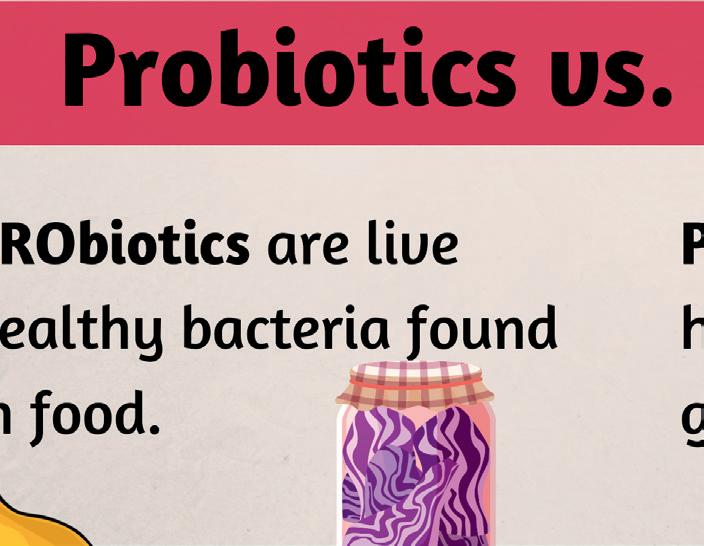
These flavorful cookies are deceptively full of microbiome-feeding nutrients that will get your skin glowing and your heart pumping. The best part: All by themselves they are a balanced breakfast … or lunch … or midnight snack!


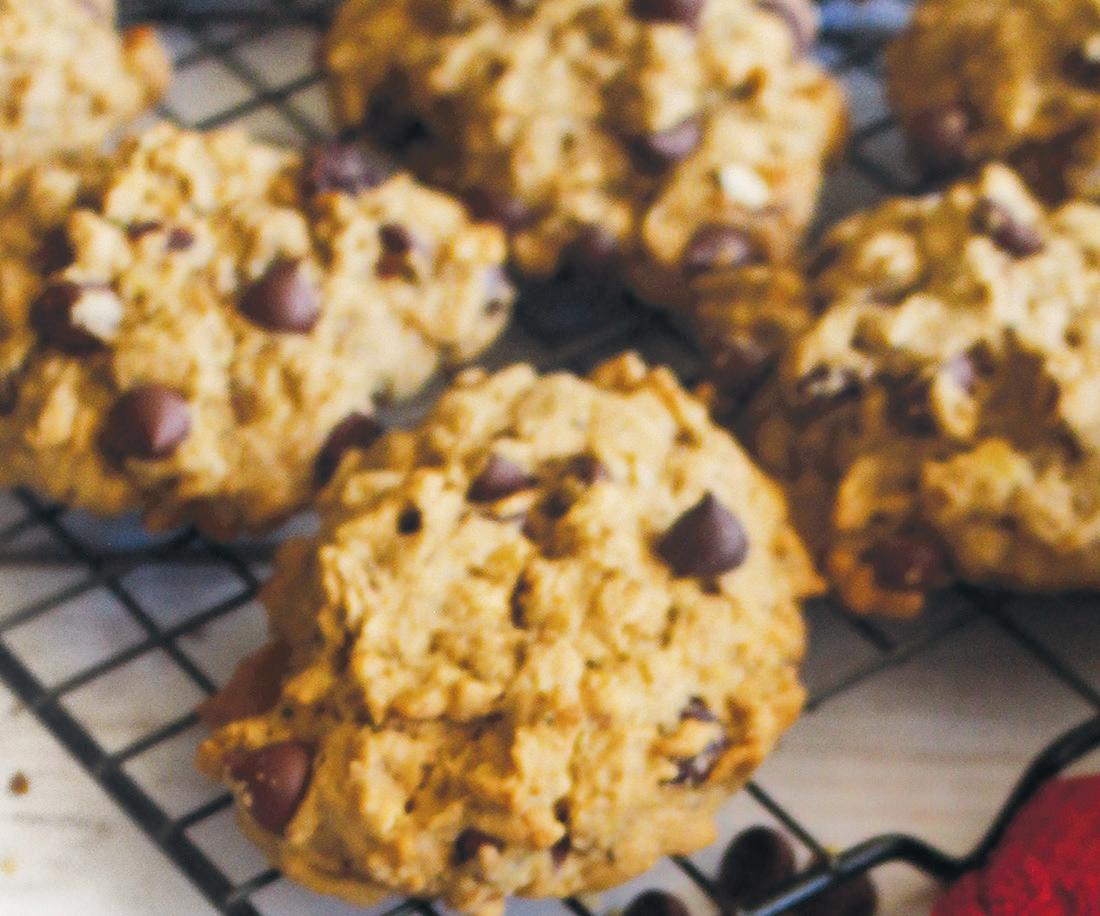
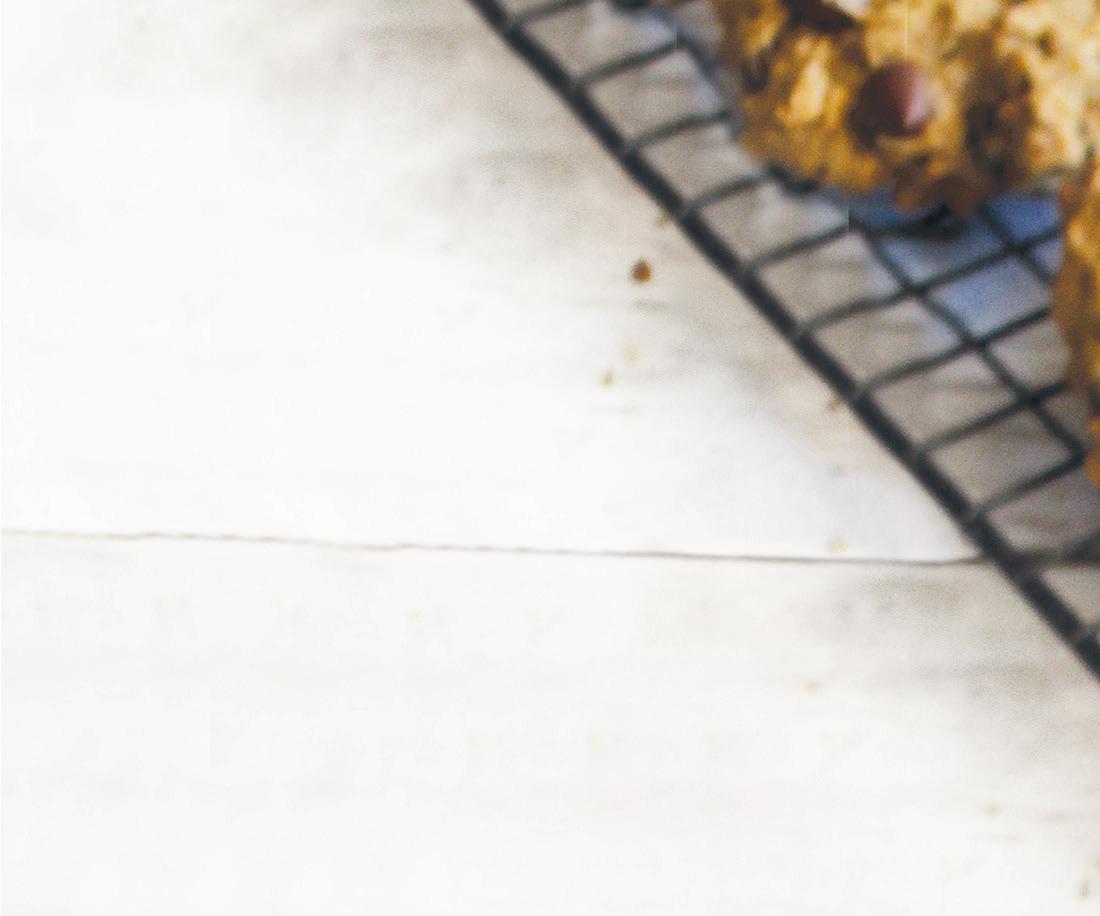
Makes 24–30 cookies
1½ cups gluten-free flour


1¾ cups organic rolled oats
1 teaspoon baking soda
1 teaspoon sea salt
1 teaspoon pumpkin pie spice
½ cup peanut butter (or other nut butter)
½ cup butter, softened
½ cup ground flax seeds (see Chef Note)
1 tablespoon ground hemp seeds
1 tablespoon ground psyllium husk
1 tablespoon ground chia seeds
½ cup almond milk (or other nut milk)


½ cup packed brown sugar
½ cup coconut sugar

2 eggs
1 teaspoon vanilla
Optional add-ins, ½ to 1 cup of each

Dark chocolate chips
Unsweetened coconut flakes
Dried cranberries (find a brand that’s sweetened with fruit juice)
Nuts (walnuts, pecans, slivered almonds, pumpkin seeds, etc.)
Raisins
Preheat oven to 350°F.
In a medium mixing bowl, add flour, oats, baking soda, salt and spices and whisk until well mixed. Set aside.
In a large bowl or stand mixer, add peanut butter, butter, ground flax, hemp, psyllium husks, chia and nut milk and beat until creamy.
Add sugars, eggs and vanilla. Beat until creamy again.
On low speed, mix in dry mixture until fully incorporated.
Add in at least 2 of the optional add-ins (I recommend chocolate chips, nuts and cranberries to start) and stir to incorporate.
Line a cookie sheet with parchment paper or a silicon mat. Space about 2 tablespoons per cookie at least an inch apart on the sheet. Bake 11–12 minutes.
Remove from oven and cool on wire rack.
Ground flax can go rancid, so it’s best to buy fresh whole seeds and grind them in a coffee or spice grinder just before adding.
Between two houses on a residential street in Sun Valley, a wooden fence blocks off what appears to be an empty lot. Look closer and posters touting events on beekeeping and potting soil indicate something else is afoot. That something is a halfacre urban farm started by Joni Albers.
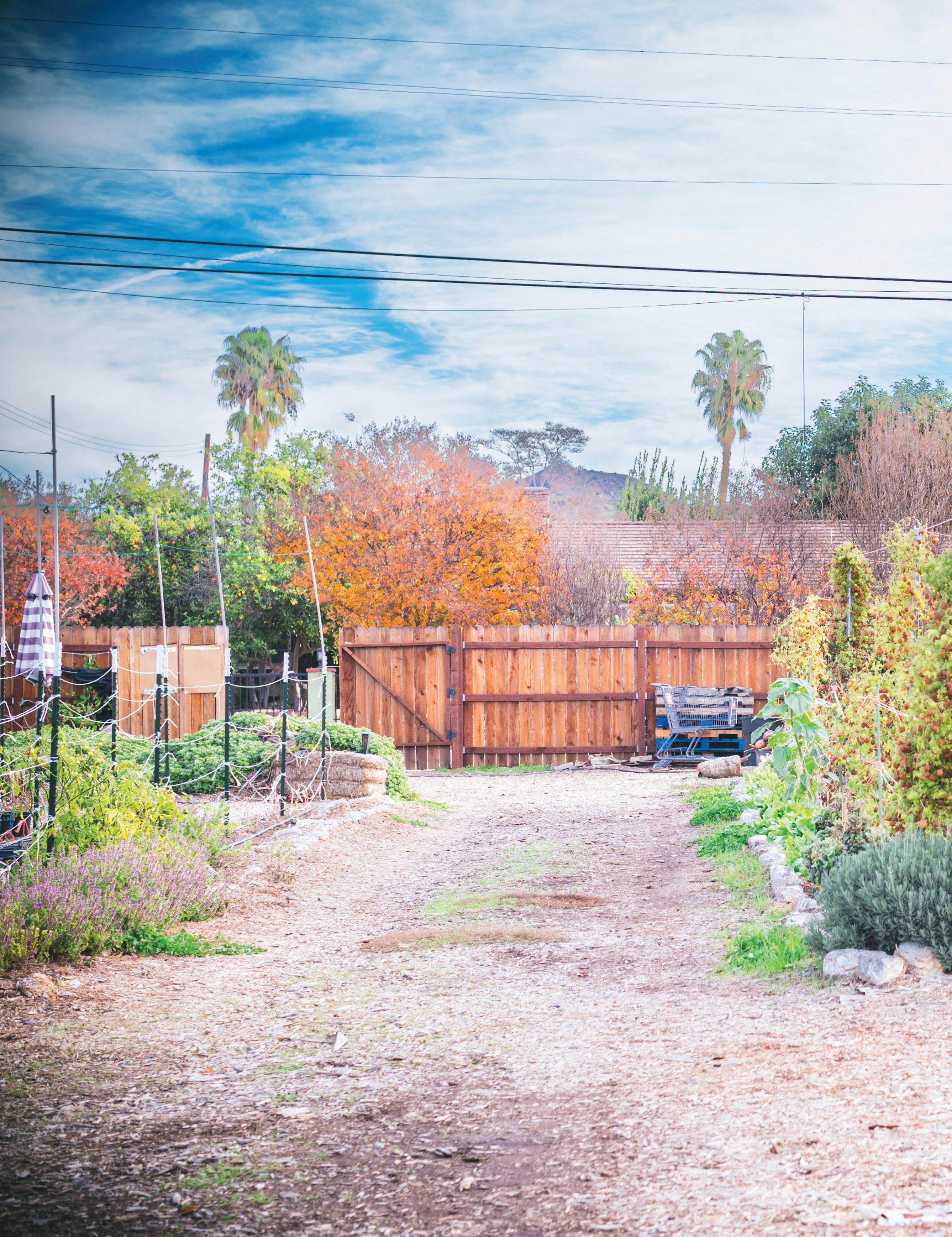
Albers’s foray into urban farming began in January 2020 with raising heirloom tomato seedlings for farmers’ markets. She grew these at her home, but when COVID catapulted demand, Albers started scouting for more land. She found it across the street in a vacant lot


owned by the adjacent Villa Scalabrini, a retirement community with residents living in a mix of independent and assisted living.
The Villa Scalabrini management was initially skeptical of Albers’s proposal to farm the lot, but they saw the value after a tour of Albers’s home-based urban farm and her promise that they could choose some of the food she grows to help feed their residents. Produce from the back 40 feet of the property now goes directly into their kitchen. Albers also provides residents with education and events, including pumpkin carving in the fall.
The lot is known as “the big farm,” and is one of Albers’s three urban farming sites—along with her home, aka “the little farm,” and another neighbor’s underground bunker where she grows microgreens—that comprise Hungry Gardens.
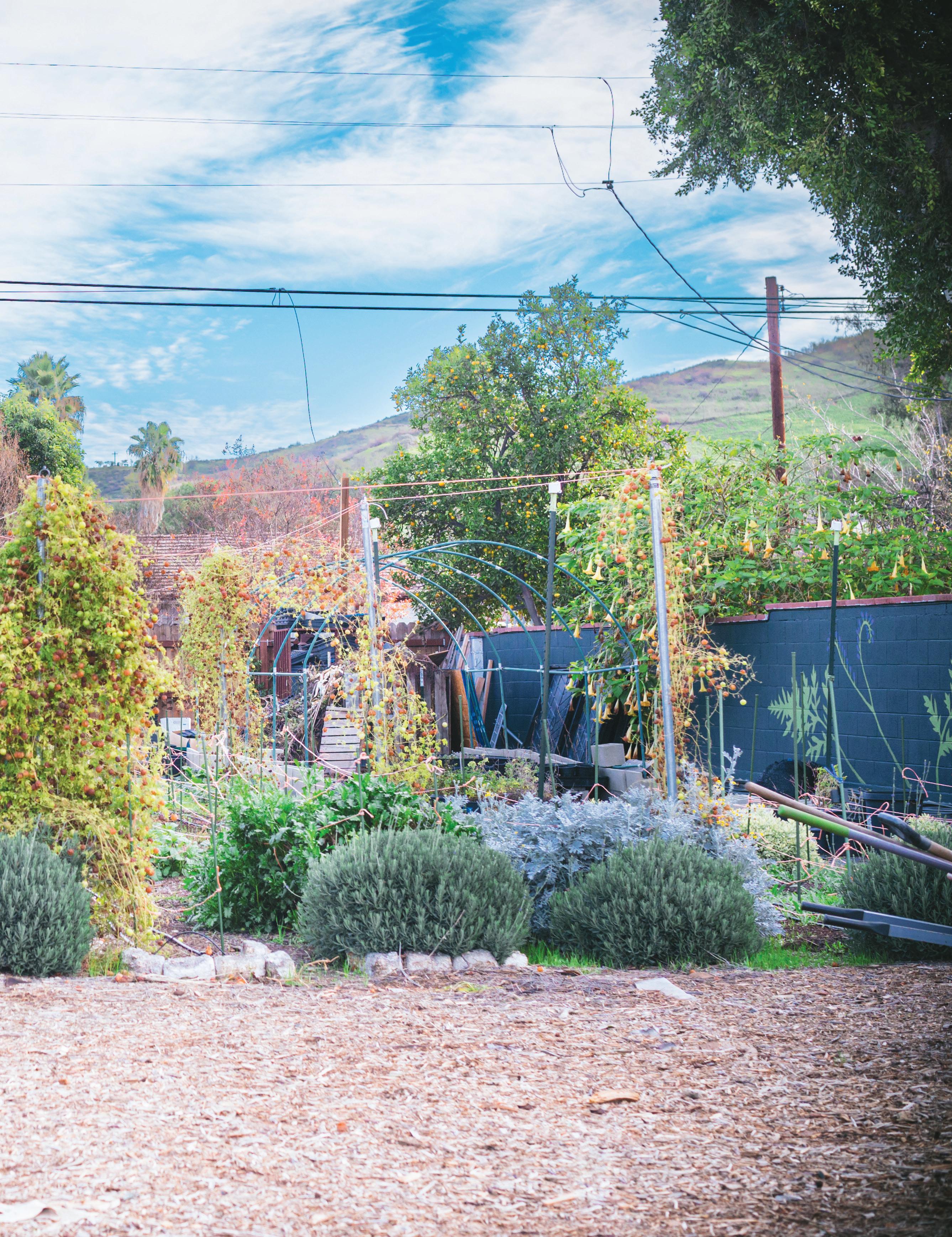
In November 2020, Albers took possession of the big farm, planted a cover crop to fix nitrogen in the soil, tore it up in February 2021, and planted in the spring. By fall, she was selling produce from the site to high-end restaurants and personal chefs, all of whom remain customers today. They buy everything from mushrooms to micro-
greens, as well as heirloom offerings, including peppers, tomatoes, herbs and edible flowers.
The journey from vacant lot to soil vibrant enough to produce food for the best chefs in town was challenging. The land had been without organic matter or water for three years, and Albers leaned on a hybrid of regenerative, biodynamic, permaculture and other organic practices to restore it. These include her integrated pest management (IPM) solution, which relies on a combination of mulch and patience.
The mulch provides protective barriers between rows of crops,


In two years, with her word and her labor, Joni Albers has restored an urban landscape to a source of abundance for her community and beyond
while the patience is exemplified by how she handled an infestation of aphids on several red noodle bean plants: Seeing that the aphids weren’t spreading, Albers held her nerve and did nothing. After two weeks, nature delivered ladybug larvae, and soon “it was like a museum of ladybugs” eating the aphids.
“We inspired an immune response by the ecosystem just by waiting,” Albers explained. Those ladybugs went on to manage pests all summer long.
Albers grew up on a wheat and cattle farm in Kansas. Her grandparents had a dairy farm, and many of her extended family also farm. Despite her agrarian roots, Albers spent over 20 years pursuing other professions, pursuing interior design in Denver and tech and media in New York City before embracing farming as a career. Her work is so different from cattle farming that her father barely recognizes it as the same job, but one commonality is an obsession with weather. And here in Southern California that means heat and drought.
“I am totally a water miser,” she laughs when asked about drought. She has to be, not least because the cost and logistics of bringing an agricultural water line to her site would be prohibitive. Operating with a residential line, she relies on drip irrigation, light aerial sprinkling and sunshades, which cool things by 15°F.
However, Albers is also adjusting what she grows. “My identity is growing heirloom tomatoes, and I’m probably not going to plant them next year due to their need for a lot of water and increasing water costs and restrictions.”
In the wheelbarrow and stacked in front of the mural are the blocks leftover from mushroom growth and harvest, used as further tools for pest control.

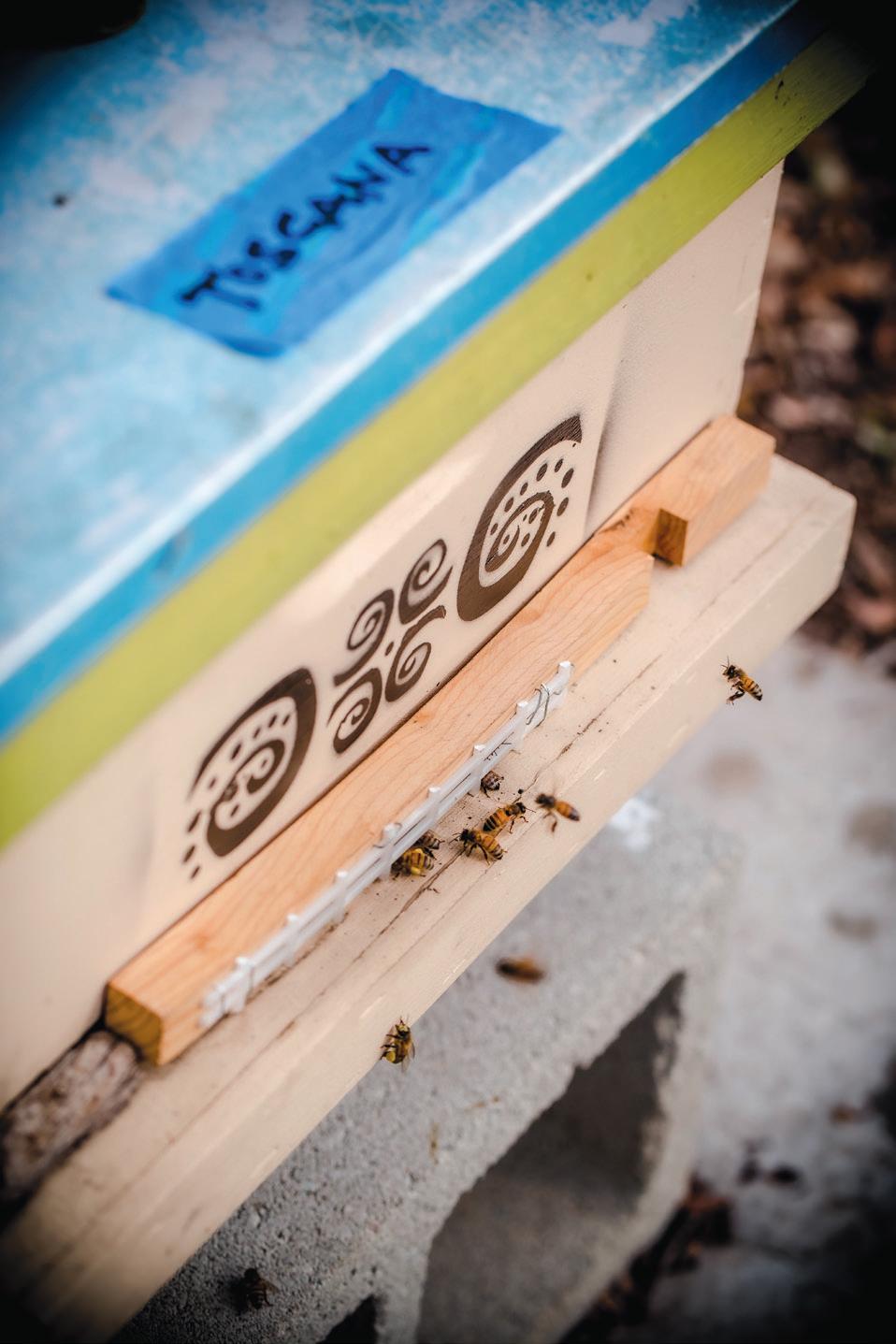
The mural featured in these images was done by young art students working with Ruckus Roots, a grassroots social impact organization whose purpose is to cultivate creativity for and about nature to bring equitable arts access and climate resilience, and in partnership with local designers at Studio Tutto.
Mushrooms and microgreens are the longterm focus of her operation. Both can be grown underground with low water usage and solar power. They’re also high-nutrition crops: Mushrooms provide an affordable source of protein, and, according to Albers, when held in the sun for three minutes, naturally occurring vitamin D.

For now, a repurposed DiGiorno pizza truck on the big farm houses Albers’s mushroom-growing enterprise. Inside, shiitakes bloom like popcorn, and wire racks heave with black pearl, king trumpet, oyster and lion’s mane varieties—which Hungry Gardens sells at the Burbank and Montrose weekend farmers’ markets.
And while Albers might not be growing heirloom tomatoes in 2023, she’s still encouraging others to experiment in their own backyards. Spring workshops on the big farm will include “starting your own seedlings,” for which she will open their seed library to participants.


On my way out, Albers hands me not seeds but lemon drops—tiny bright yellow peppers she describes as “hotter than a jalapeño with incredible flavor.” That evening in a modest dish of rice and beans, those piquant slivers delivered both on Albers’s word and her labor—two years of restoring an urban landscape to a source of abundance for her community and beyond.
Jennifer Richardson is the author of Americashire: A Field Guide to a Marriage, an Indie Reader Discovery Award winner for travel writing. She and her British husband consider themselves lucky to call both Ventura and a village in the English Cotswolds home. To learn more, visit JenniferRichardson.net.

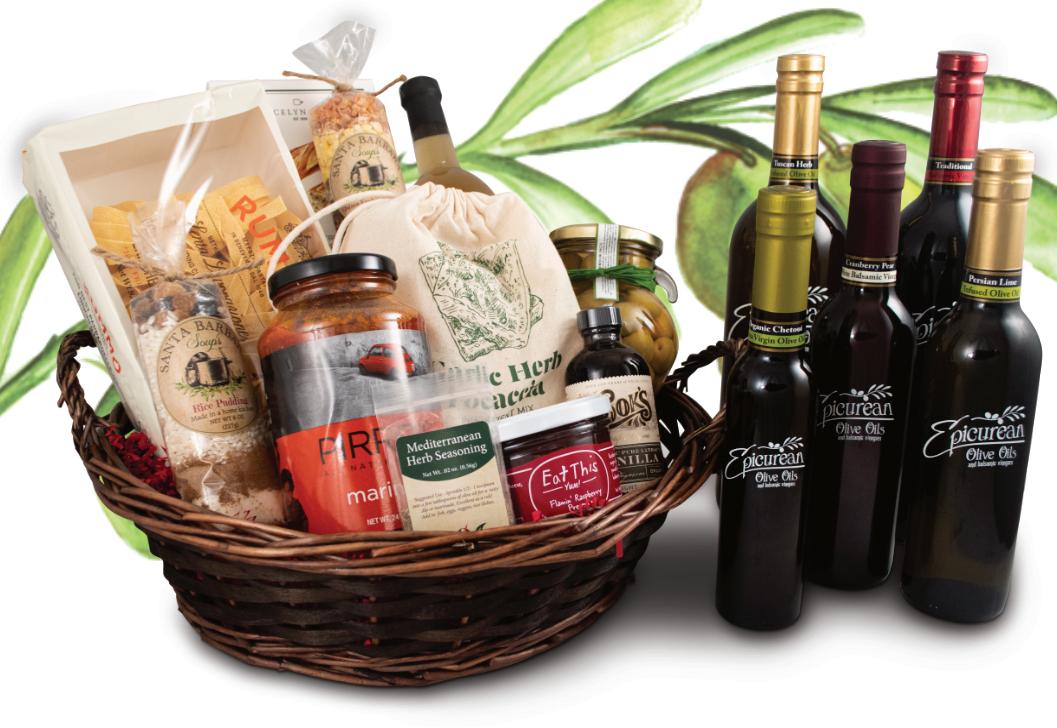
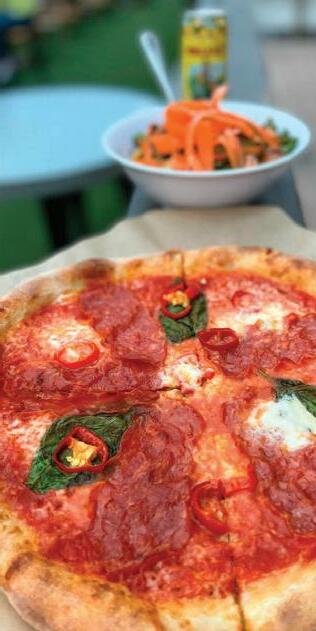



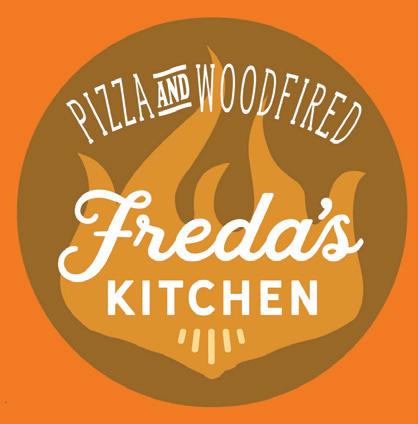





 BY JENNIFER RICHARDSON | PHOTOS BY VICTOR BUDNIK
BY JENNIFER RICHARDSON | PHOTOS BY VICTOR BUDNIK

In February 2022, Laura Yochum opened the second branch of her sustainable home goods and refill shop, Prostainable, in Granada Hills. The original, in Woodland Hills, opened in October 2019. Both are lowwaste stores designed to make sustainable domestic life easy, beautiful and fun.




Yochum’s advice for anyone embracing zero-waste intentions is to start small. “Baby steps,” she advises me when I confess to a grotesque use of paper towels in my own kitchen. She then proceeds to confirm that “the kitchen is the most wasteful room in our home, mostly because of food waste.”




She advises her customers that the kitchen, along with the laundry room, is a great place to start reducing your household waste, noting that “the bathroom is very personal—that may take longer.” Her practical advice in the kitchen is to use up the plastic sponges and brushes that you have, then switch them out for loofah sponges and wooden or bamboo brushes, all of which are compostable. Bamboo and glass straws are also practical and popular choices.
“Dish soap is an easy one,” she adds. At Prostainable, customers can refill their own containers with dish soap that’s grey-water safe, which means you can water your garden with the same water you have used to wash your dishes. Yochum sources her 55-gallon drums of dish soap, laundry liquid and hand soap from Los Angeles, saving on shipping waste and supporting the local economy.
Another way Yochum supports the local economy is with a “local goods corner” at Prostainable. This allows vendors to rent shelf space in the front of the store to showcase their goods. Vendors include flower farmer Pia Villasenor, whose dried flowers have been used in Yochum’s candles and soaps, as well as jewelers, ceramicists and small-batch skincare product producers.
In addition to the products she sources locally and beyond, Yochum is a product producer herself. She is certified in permaculture design, a program she completed right as the world was shutting down with COVID, with the goal of making soaps, beauty products and cleaning products with ingredients from her garden. These include lavender, orange rinds, rosemary and rose petals. She also uses native sage purchased from Theodore Payne, a San Fernando Valley–based nonprofit nursery specializing in California native plants.
The Granada Hills location of Prostainable is twice the size of the Woodland Hills site, which gives Yochum the space to both make products and hold workshops on subjects like cold-pressed soap and candle making. It also allowed her to test a consignment concept for secondhand fashion, where instead of cash back Yochum provides store credit. The endeavor has been so successful, she’s now doing it at both locations. What she doesn’t resell is donated to Hope of the Valley Rescue Mission, a nearby nonprofit.
Yochum’s community outreach also included sponsoring an internship for Cal State University Northridge’s (CSUN) Sustainability Program, which she plans to do again in 2023.

In addition to the two retail locations, Prostainable goods are available online at Prostainable.com, where users can sign up for Yochum’s weekly newsletter, Sustainable Saturdays. It is a one- to two-minute read on all things sustainability. A recent newsletter highlighted where to recycle common items, from underwear to appliances. It’s further proof of Yochum’s commitment to Prostainable’s mission: “to make you feel as good as we do about living in a sustainable home.”
Opposite: Laura Yochum, seen here inside her second Prostainable refill shop in Granada Hills, is certified in permaculture design and uses the extra space in the store for workshops, clothing consignment and to make her own locally sourced products. Besides grey-water-safe dish or hand soap and laundry detergent refills, customers can find sustainably made products from kitchenware to pet cleanup.
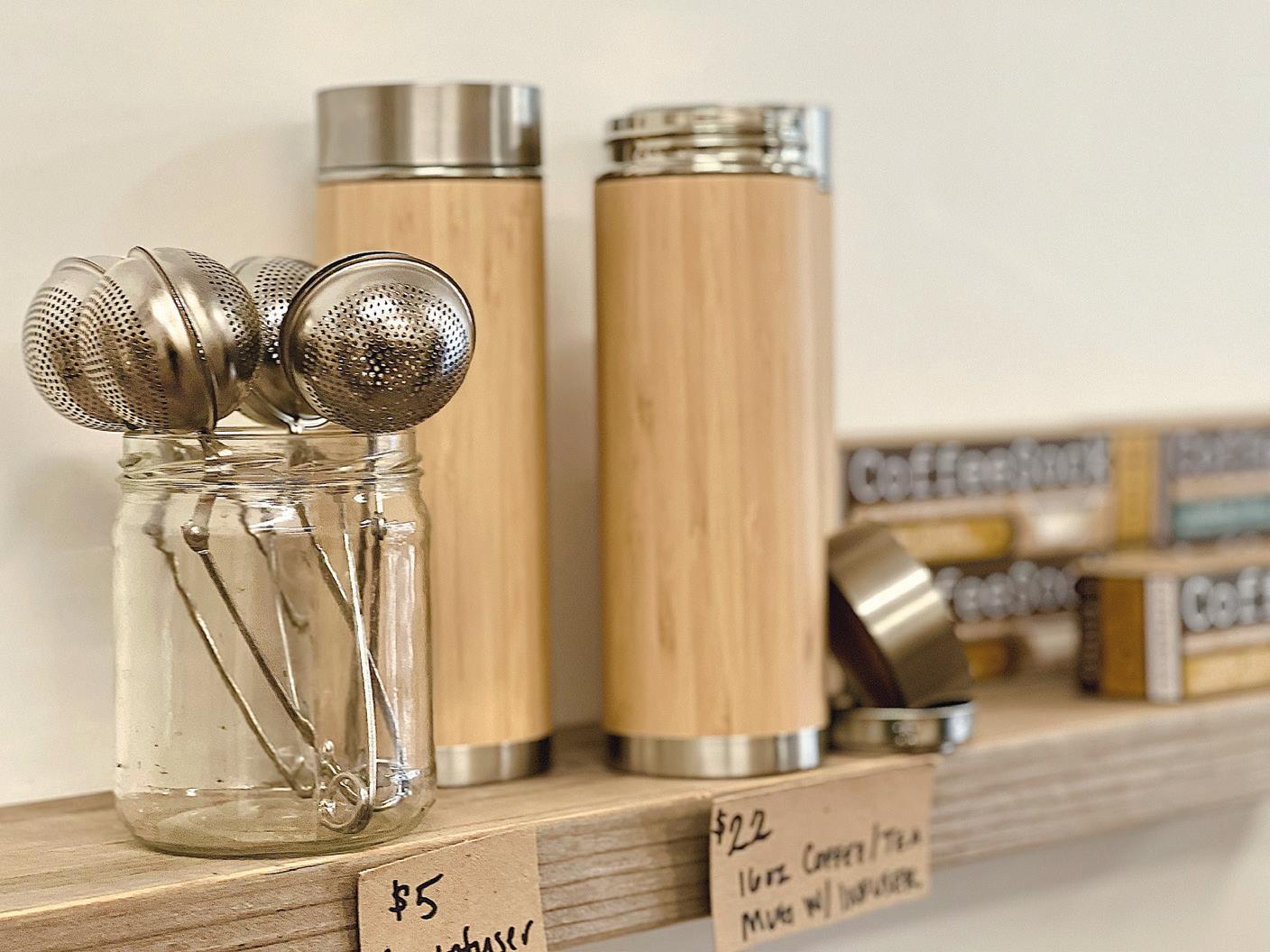
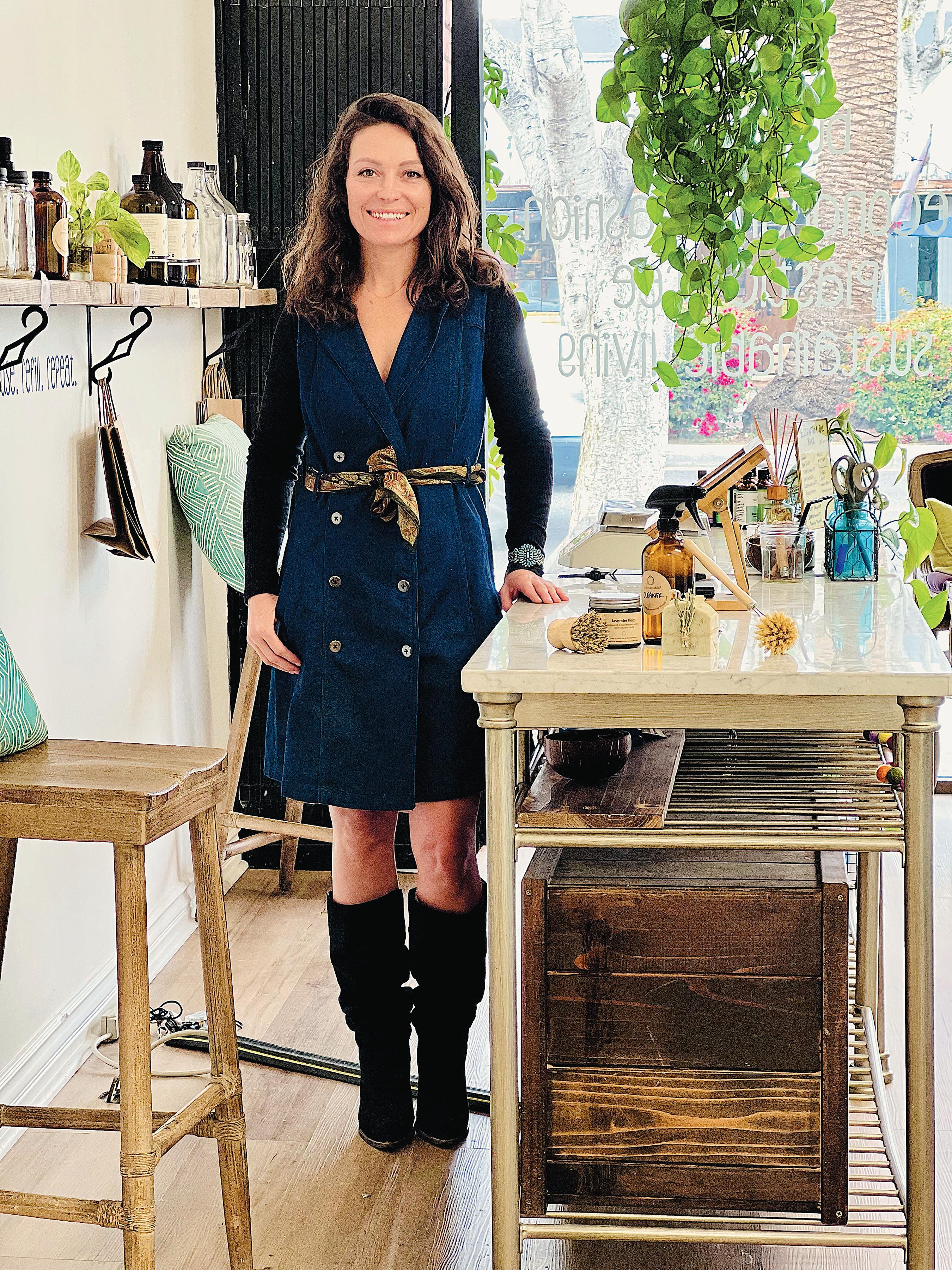





Besides the usual suspects of market vendors (a full list of which can be found at SEELA.org), the Atwater Village Farmers’ Market boasts various zero-waste and social equity collaborations. LA Compost picks up locals’ food scraps and other nonprofits take donations. LA Community Fridges, (on Instagram @lacommunityfridges), fills several community fridges as a way to help with both mutual aid and waste diversion.
For the past 12 years, vibrant laughter, smiling faces, sun hats and babies in strollers have graced the corner of Glendale Boulevard at Larga Avenue on Sunday mornings. The Atwater Village Farmers’ Market— run by the nonprofit organization Sustainable Economic Enterprises of Los Angeles (SEE-LA)—offers a sense of home to its guests. There is an earthy smell of fresh produce mixed with the food that customers can buy to eat as they shop. Regulars treasure the visual appeal of multiple stalls and their wares, the leisurely pace of the customers as they peruse the market and the sound of mingling conversations.
At the stall where the Kenchan Ramen do-it-yourself kits were displayed, I stopped a moment to check them out and chatted with the vendor. Impressively pinning me as an avid viewer of NBC’s “The Bachelorette,” she suggested purchasing a pack to share with a bottle of Pinot Grigio, to host a girls’ night of ramen and TV roses. (Also, how did she pin me so quickly as an avid viewer?)
But this market serves a greater purpose than providing dinner for my girls’ night. SEE-LA is a 501(c)(3) nonprofit that provides nutrition education, food access and opportunities for small regional farms and local small businesses to thrive using sustainable food systems. The farmers’ market program encapsulates this mission quite well. At the markets, customers can use such benefits as CalFresh EBT (formerly known as food stamps), as well as Special Supplemental Nutrition Program for Women, Infants and Children (WIC) and Senior Farmers Market Nutrition Program checks (FMNP). Even better, Market Match—California’s healthy incentive program that matches EBT funds with additional market dollars—is offered at all SEE-LA markets.
Interim co-directors of the program Elizabeth Bowman and Cara Elio operate a network of seven community-based certified farmers’ markets in Los Angeles, including Hollywood, Baldwin Hills and the LA River in DTLA.


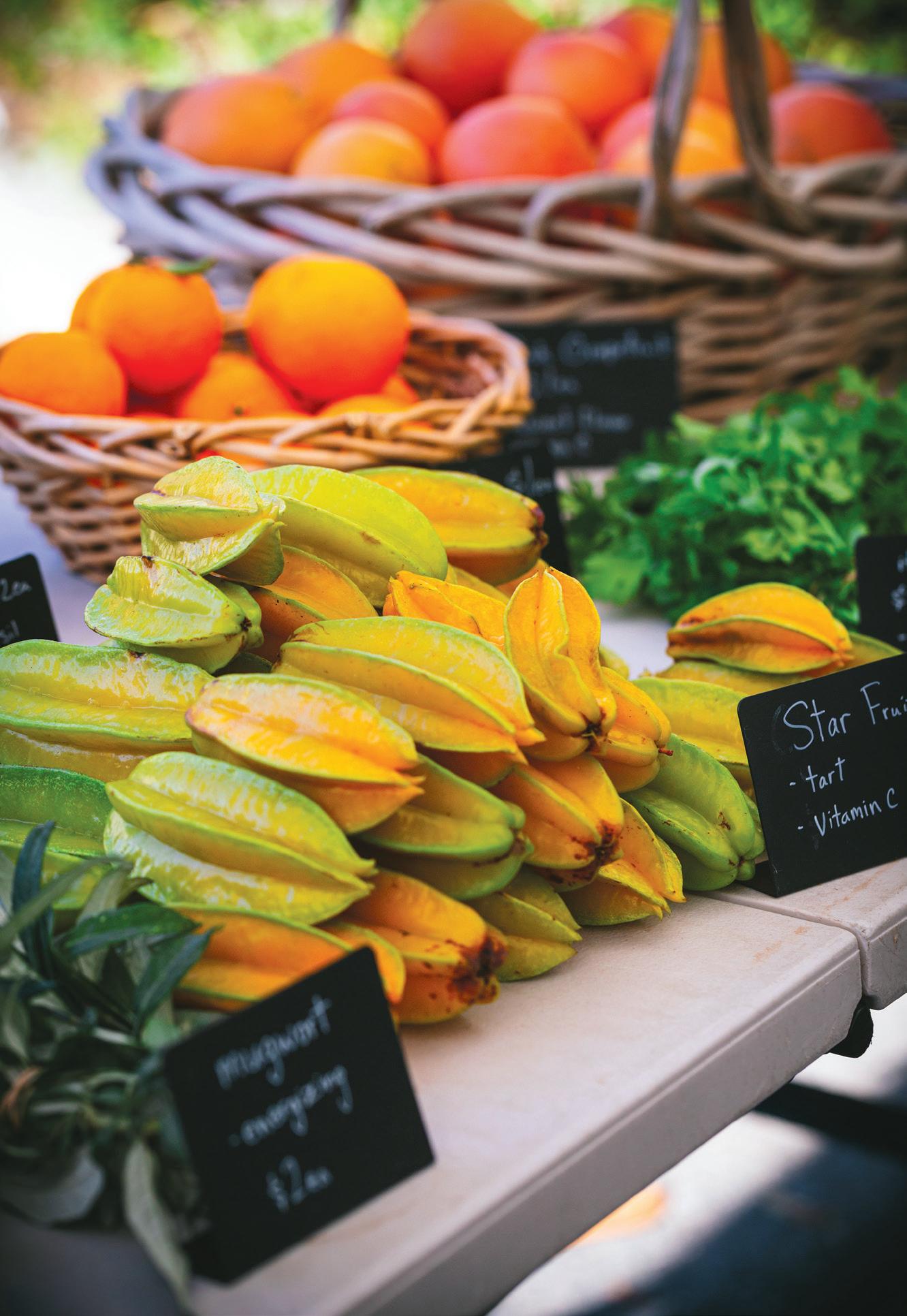
The duo also champions programs that provide extensive nutrition education to low-income families and to children in underserved schools. At the Atwater Village market, representatives from SEE-LA host a booth meant to educate the public on the health benefits of seasonal market produce.
Bowman has been with SEE-LA on and off since 2012, beginning with the Hollywood Farmers’ Market, founded in 1991. Her responsibilities include overseeing market managers, health educators, nutritionists, program leaders and on-site teams to assist during the day, totaling around 35 staff members. Duties for the on-site teams include setting up the market fair, trash cans, signage and booths plus educating the public. There is a lot of physical labor needed at each market. Shifts begin early in the morning when workers come into an empty space, then fill it up with everything needed, only to break it down hours later after the market closes in the afternoon.
Gustavo Jimenez, a vendor who owns Jimenez Family Farm with his wife, Marcie, produces grass-fed meats and sausages and seasonal vegetables and fruits, and raves about the warmth and accessibility of the SEE-LA team.
“I’m very happy with the organization. All the people are very nice,” he says. “I leave at 4am to drive from Santa Ynez and arrive around 7:15am, and the team helps me put everything out together.” Jimenez has been selling his produce at the Atwater market for more than 10 years and describes it as “a well-oiled machine.”
Other than providing quality foods, there is a strong sense of stability with SEE-LA. Some say that with the restrictions that COVID-19 produced, farmers’ markets have been a strong pillar throughout the chaos we’ve been through. Bowman acknowledges the heightened challenges while doing community-facing work during COVID, and the need to give the staff the appropriate training through unstable times.
“Our utmost responsibility was to meet those challenges while maintaining the team’s sense of safety and productivity. We did what we had to do,” she says.
Everett Davall, farmer/owner of Dates By Davall, agrees. “SEE-LA worked hard to keep the market open throughout quarantine, and customers found peace of mind with good quality and sustainable food,” he says. “SEE-LA works hard to keep vendors here and bring the best of the best to the market. We are honored to be a part of a system that provides quality food, and to be a reliable resource.”
SEE-LA’s nutritional classes are open to the public at the markets and at different community sites across Los Angeles County. Events in the community, such as recipe demonstrations led by health educators, “focus on building basic skills that enable participants to confidently make healthy nutrition choices.”
Chef Megan Tucker owns vegan Jewish deli Mort and Betty’s, which has been at the market since November 2022. She has previously been seen at Smorgasburg in DTLA and works out of Crafted Kitchen, also in DTLA.
Collaborations with other sustainably focused organizations include L.A. Compost, which does pickups at the markets, and Urban and Environmental Institute at Occidental College, which partners with SEE-LA to ultimately increase access to fresh produce in low-income and low-food-access communities while providing an enhanced market opportunity for regional farmers. Occasionally, Prosperity Market (a farmers’ market/food truck on wheels) partners for pop-up events at the Hollywood market.
Atwater Village Farmers’ Market, open every Sunday from 9am to 2pm, is located at 3528 Larga Ave. in Public Parking Lot 646, Los Angeles. Their updated Farmers’ Market list is available at SEELA.org.
Emma Roberts has always been in the hospitality business in a variety of ways, starting as hostess and moving her way up to managing restaurants/bars food and beverage reviewer, and avid home mixologist. She enjoys thoughtfully curated culinary experiences and living a healthy lifestyle, such as hiking and strength training.


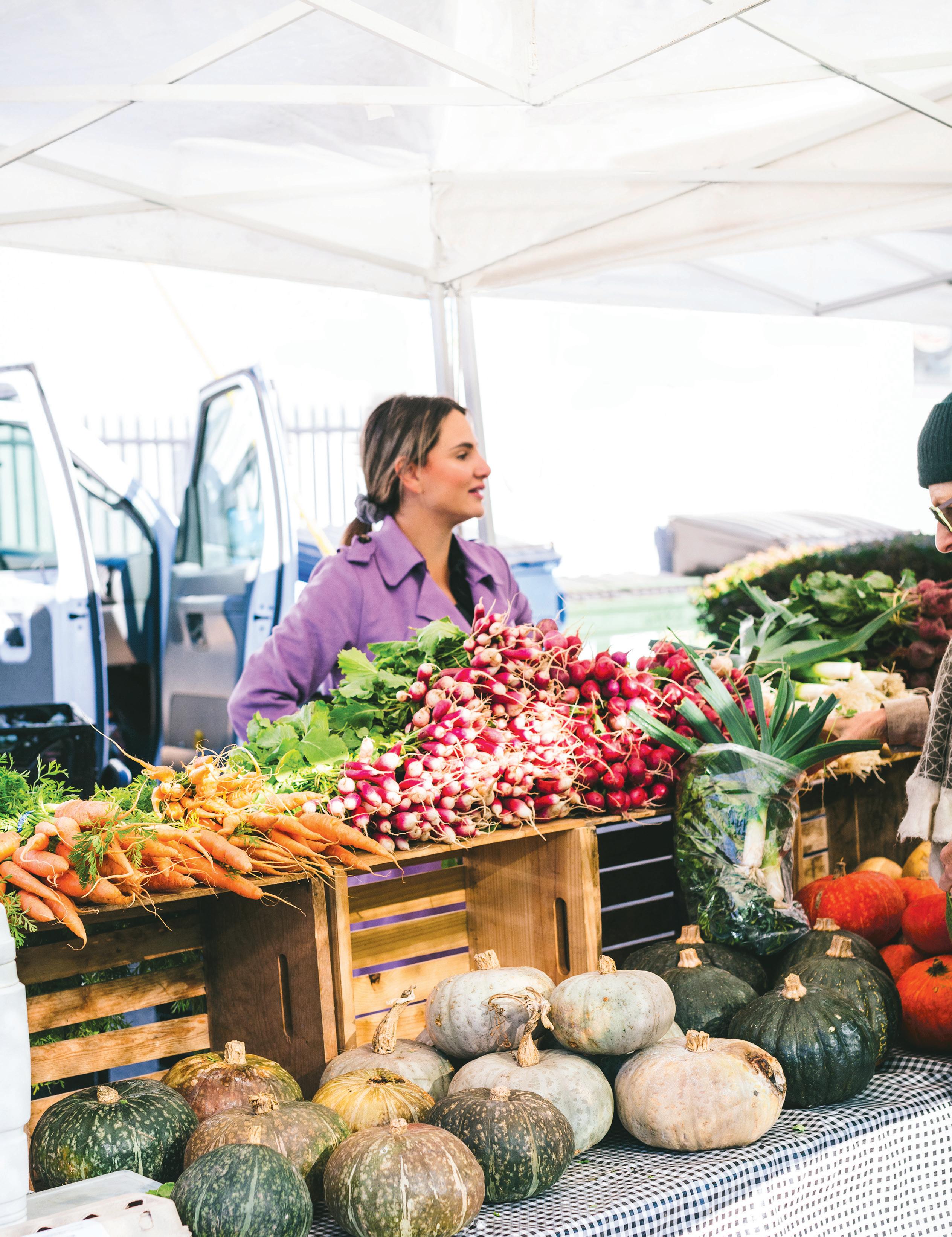 BY ERIN DAVY | PHOTO BY CAROLINA KORMAN
BY ERIN DAVY | PHOTO BY CAROLINA KORMAN
Farmers’ markets are a foodie heaven. It’s so fun seeing what everyone has brought to market. The smells and the flavors are unparalleled, and freshness rules.
As a devoted locavore with over 10 years working in SoCal farmers’ markets, I make a concerted effort to buy local wherever possible. Here are some of my best tips for how to make the most of your market shopping. Some of these are for beginners and some are more advanced. Whatever your situation, I encourage you to get out there and “support local.” Your taste buds will thank you!
Get there at least 15 minutes early to get good parking and to get in line to enter the market. Bring your mask and bags; wear comfy clothes and shoes, a hat and possibly layers. Especially for your first time, it can easily take anywhere from 30 minutes to two hours to really check everything out. Do a lap before you buy anything. Don’t rush. Enjoy it!
It helps to plan out your purchases. Consider bringing a wagon or wheeled cooler with ice packs. Remember that some items are heavier (juice, milk, meat) so either pick those up last or plan to go drop things into a cooler in your car. Another tip for cold items is to ask the seller if they can hold it while you finish shopping. Just don’t forget to go back to pick up!
Bring cash in small bills for exact payment. Many vendors accept credit/debit cards (and some prefer it due to COVID safety procedures) but don’t count on it. Some markets offer an ATM (or know of one nearby).
If you’re on a strict budget, make sure you shop the more expensive items first. Some perishable items like flowers, produce and baked goods might be marked down towards the end of the market, but proteins and canned items usually are not because they will keep to sell at the next market.
Talk to other shoppers while you wait in line, ask them about what they are getting, and even if they have other favorite booths they want to share with you. You might even make a market friend! Don’t forget to remain physically distant!
Look for the words that matter to you: Sustainable, Biodynamic, No Spray, No Pesticides, Non-
GMO, Pasture-raised, Grass-fed… If you aren’t sure what they mean or don’t see any signs, ASK! If the person behind the table doesn’t know, ask if you can call or email the farmer.
Support your farmers and vendors on social media and don’t forget to recommend them to your friends and family! Talk to them about what you made last week with their product and how much your family loved it. Maybe they will be willing to set things aside for you, or bring your standing order each week. Some farmers offer a CSA or loyalty program for their devoted customers.
Many of the vendors and farmers now have websites (or at least an email address) where you can place an advance order to pick up at market. You win, because you’ll get what you wanted, and they win, because it lets them pack what you ordered and still send enough of everything to the market for other customers.
Bring your own shopping bags, including smaller ones for produce (save store bags and use them too!). You can bring egg cartons and berry baskets back to the farmers to reuse. Some vendors that sell loose/bulk things like sprouts, beans or nuts might like it if you bring your own container, like a jar. Be creative, figure out what works for you (and ask about any specific COVID safety procedures)!
The farmers and vendors count on you—that’s why they are there—but more than that, they appreciate you! Keep that in mind when you go, and take a moment to appreciate back. Make it part of your week and just go with the flow, savor the whole experience and build community around you.
Farm-lovin’ Erin Davy is a farmers’ market enthusiast whose life has always centered around food, farms, friends and family. She and her husband, Joe Bacon, and their adorable doxie, Finn, are now traveling full time. You can follow their farmers’ market tours and other “adVANtures” on Instagram @thebaconsrebellion.
PRODUCE
Acorns
Asparagus
Bacon Avocado Broccoli Rabe
Brussels Sprouts
Cabbage Celery Cherimoya Citrons
Grapefruit Hard Squash Kiwis Kohlrabi Mushrooms
Mustard Greens
Parsnips Pomelos Radicchio Turnips Walnuts Winter Greens
FROM THE SEA Clams Lobster
Oysters Ridgeback Shrimp
PRESERVES
Cured Meats
Dried Beans
Dried Fruit
Fruit Preserves and Jams
Pickled Vegetables
Sauerkraut
Vinegars
Yogurt



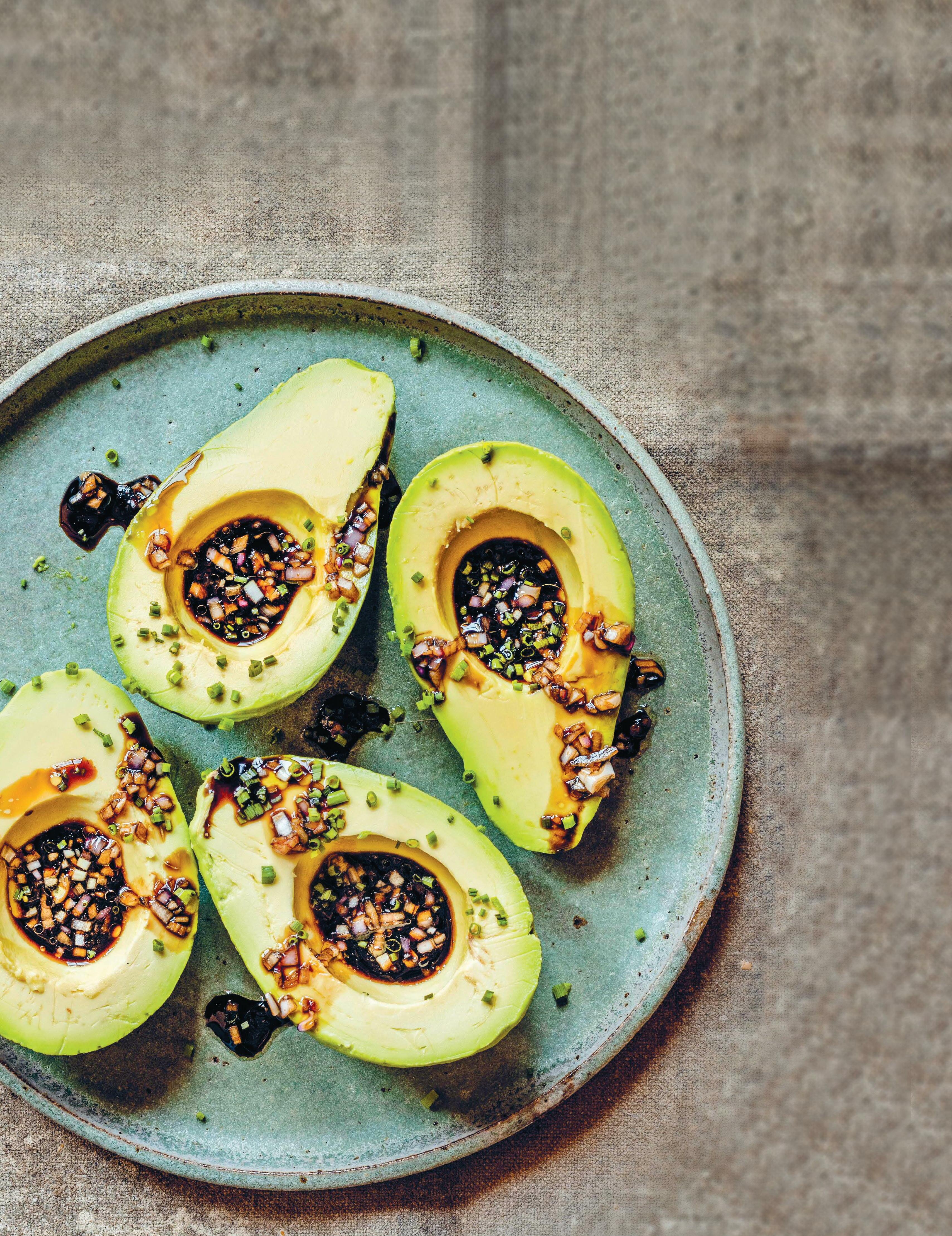 BY MOLLY CHESTER
BY MOLLY CHESTER
Molly Chester is a co-founder and farmer of Apricot Lane Farms, a 234-acre biodynamic farming project in Moorpark. Prior to farming, Molly was a private chef in Los Angeles who specialized in healing the gut through nutrient-dense culinary techniques such as soaking, sprouting and fermenting. She lives on the farm with her husband John, son Beaudie, dog Blue and a menagerie of farm animals and wildlife. Molly and John’s gentle, slow and unconventional approach has inspired other farmers, and was the subject of the 2019 award-winning documentary The Biggest Little Farm
This debut cookbook brings the bounty of the farm to readers’ kitchens. As a chef who has long understood that flavor and healthy food go hand in hand, Chester is passionate about farm-fresh ingredients, and her cooking celebrates the tree-ripened fruits, seasonal vegetables, pastured eggs and grass-fed meats for which the farm is known.
This quick and easy recipe accentuates the pairing of creamy, sweet avocado with rich balsamic vinegars. If you do not have aged balsamic vinegar, substitute additional unaged balsamic and a little honey for sweetness. Use the fruits when they are firm but ripe to make them easier to peel and slice. When Beaudie was only 5 years old, I served this dish for dinner, and before I scooped one for myself, he had eaten the entire plate of four halves! I have learned that a small drizzle of aged balsamic on just about any food will encourage kids to eat with enthusiasm. This salad is best prepared right before serving so the natural oils in the avocado remain creamy at room temperature.
Serves 4
2 tablespoons diced shallot (about 1 small shallot)
1 teaspoon fine sea salt, to taste
¼ cup aged balsamic vinegar
2 tablespoons balsamic vinegar

2 tablespoons cold-pressed extra-virgin olive oil
2 large firm but ripe avocados, halved, peeled, and room temperature (about 1 pound)
1 teaspoon chopped fresh chives
In a small glass or nonreactive metal bowl, stir together the shallot and ½ teaspoon of the salt. Set aside for 5 minutes. The salt will soften the shallot and mellow its sharp flavor. Add the vinegars and oil and mix thoroughly.
On a serving platter, arrange the avocado halves facing upward so the interiors act as little cups for holding the dressing. Stir the dressing well and spoon over the avocado wedges. Generously sprinkle the remaining ½ teaspoon salt, to taste, and the chives over the dressed avocado wedges and serve at room temperature.
Recipe and photo reprinted with permission from the Apricot Lane Farms Cookbook by Molly Chester, published October 2022 by Avery.
Not too long ago in human history we spent most of our lives outdoors, interacting directly with the land, relying on it for our food and ways to heal ourselves. Nowadays we find ourselves increasingly behind our desks and in front of a screen. As a result, our health has declined and our connection to the natural world has disintegrated.
Spending time outdoors, in nature, has a plethora of healing benefits—lowering stress levels, improving mood and enhancing overall well-being. Add to that the practice of foraging and eating what grows locally, and your connection to the natural world around you strengthens. I often tell my students, “The greatest connection and relationship between yourself and the earth is through food.” By keeping food and foraging traditions alive, we help to rekindle that connection in ourselves and our community.
You don’t need to be an expert forager to take advantage of the healing powers of nature, just curious about the world around you.
Embrace curiosity about what important plants live in our area by taking regular walks on local trails and exploring the open spaces in your neighborhood. Take notice of the different plants and trees that grow there. Look at the various shapes and sizes of leaves, flowers and types of fruits. How does this plant stimulate your various senses? Notice how it smells when a leaf is crushed between your fingers. (But first, be sure to know ahead of time what poison oak and other poisonous plants in our area look like.) Notice where it grows most abundantly and guess its stage of growth. What other characteristics does this plant have?
Sometimes we are eager to quickly identify a plant using our instant access to online information, but when we take the time to use our senses and observe before we jump to a name, we are able to learn it more quickly and increase the ability to recognize it the next time we see it.
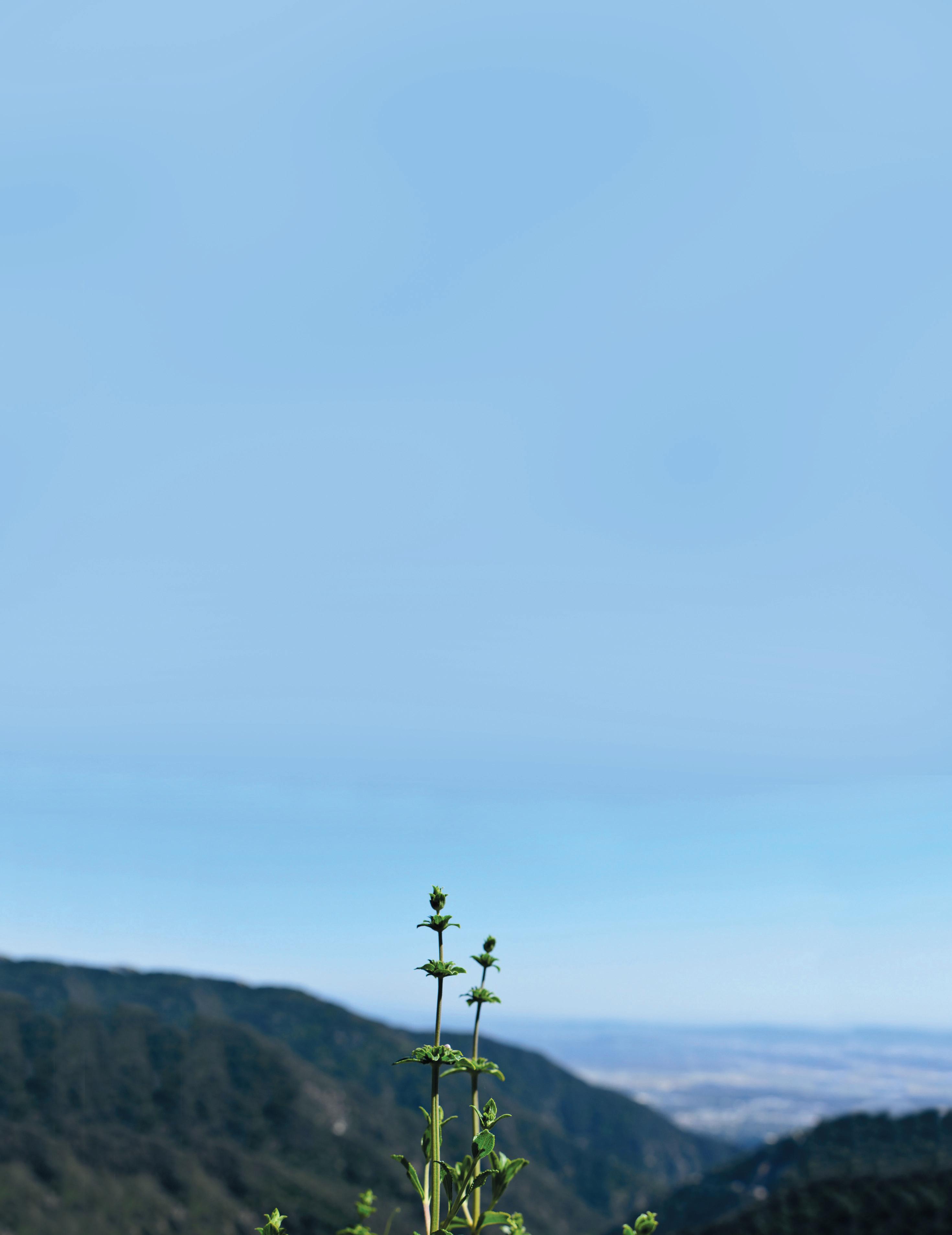
As you become familiar with the edible plants that share your environment and develop a deeper relationship with them, the landscape becomes a rich and complex language of colors, textures, smells and even tastes. By learning about and looking at nature more intimately, we naturally develop a greater respect for it. From a culinary perspective, every trail and open space has its own flavor palette—one that is not known, and may never be known, by the shopper at the supermarket or convenience store.
One of my most favorite and distinct local plants that grows abundantly in our area is black sage (Salvia mellifera). While it is related to the garden sage used in cooking, it has a deeper, stronger and more complex flavor with a hint of mint. I use this in both savory and sweet dishes and it often pairs well with chocolate. As is common with many mint-family plants, black sage also has wonderful wellness properties: It is excellent for soothing sore throats and coughs, combating viruses and bacteria and is often used as a digestive tonic.
Jess Starwood, an herbalist, forager and chef based in Thousand Oaks, educates about wild food, herbal medicine and our natural connection to the land through what we eat. She has a master’s of science degree in herbal medicine and is the author of Mushroom Wanderland: A Forager’s Guide to Finding, Identifying and Using 25 Wild Fungi available on her website. JStarwood.com
In a pot, warm the milk over low heat. Gently crush the black sage leaves by hand and add to the milk. Allow to simmer for 5–8 minutes, or until fragrant. Strain out the leaves and add cacao and honey. Combine thoroughly with an immersion blender or in a high-speed blender. Serve immediately.

1 Glendale Gateway Certi ed Farmers’ Market
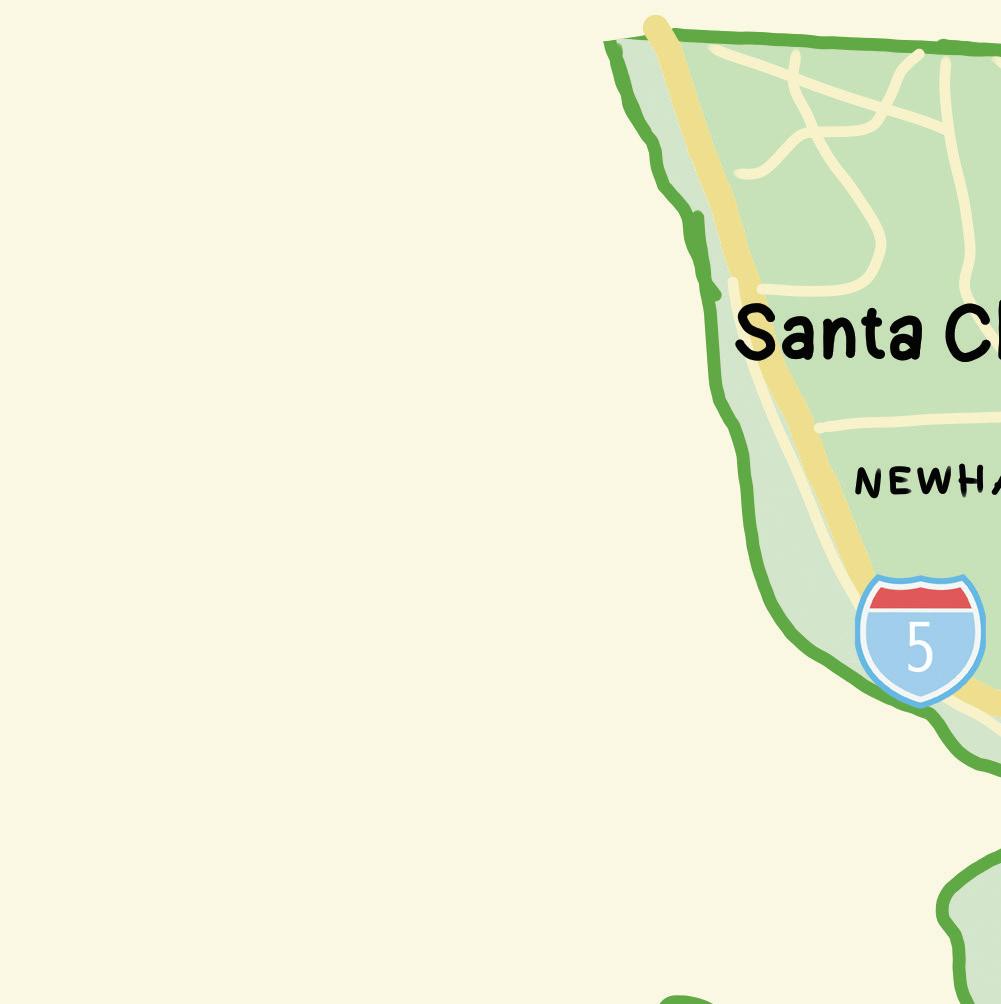
Tuesday 10am-2pm 801 N. Brand Blvd. Glendale SupportingArms.org/events.html
2 Hidden Hills Farmers’ Market (Exclusive Community Market) Tuesday 3-7pm @ccfminc
















Sherman Oaks RawInspiration.org
Tuesday 10am-2pm Tuesday 8:30am-12:30pm
10 South Pasadena Farmers’ Market
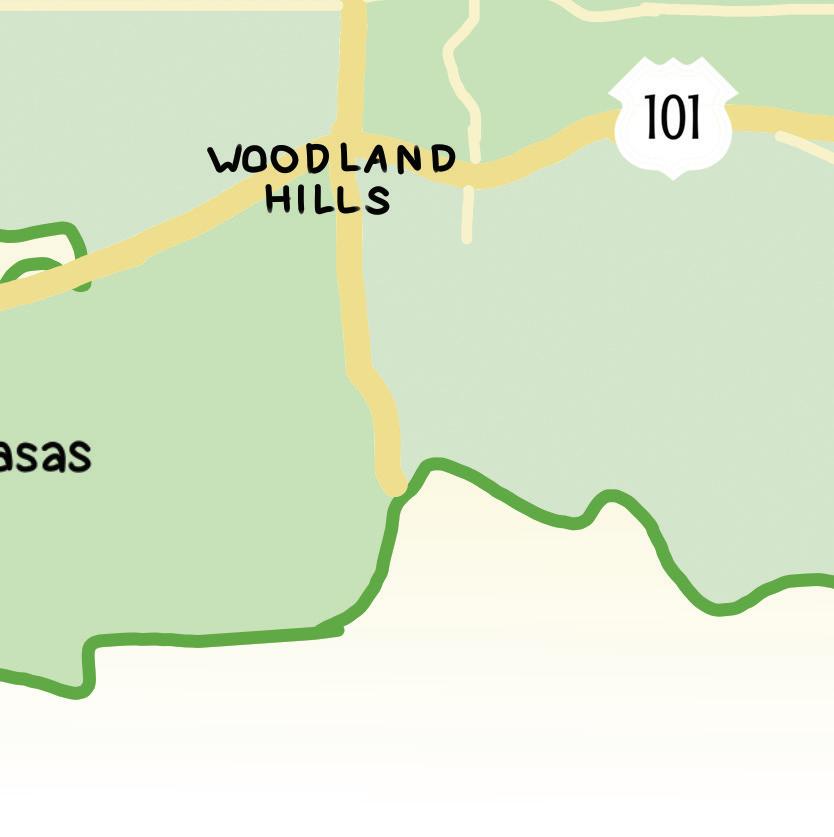
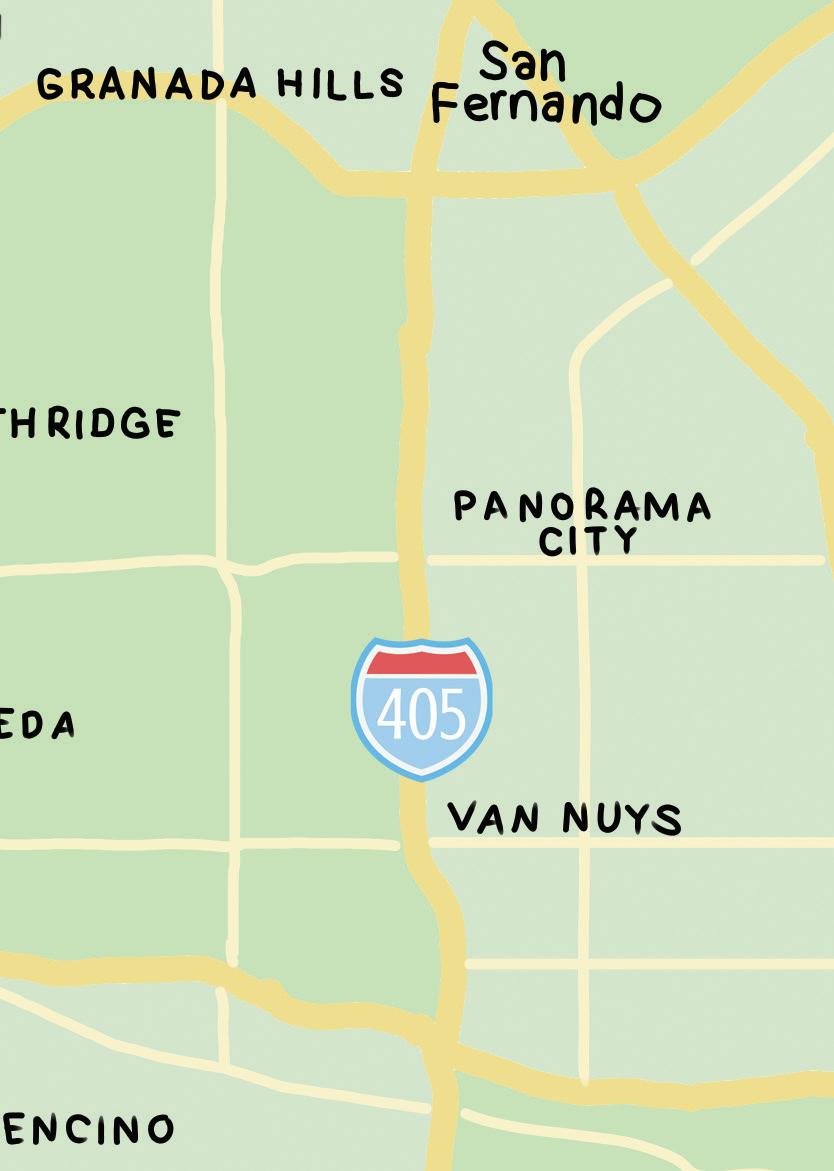
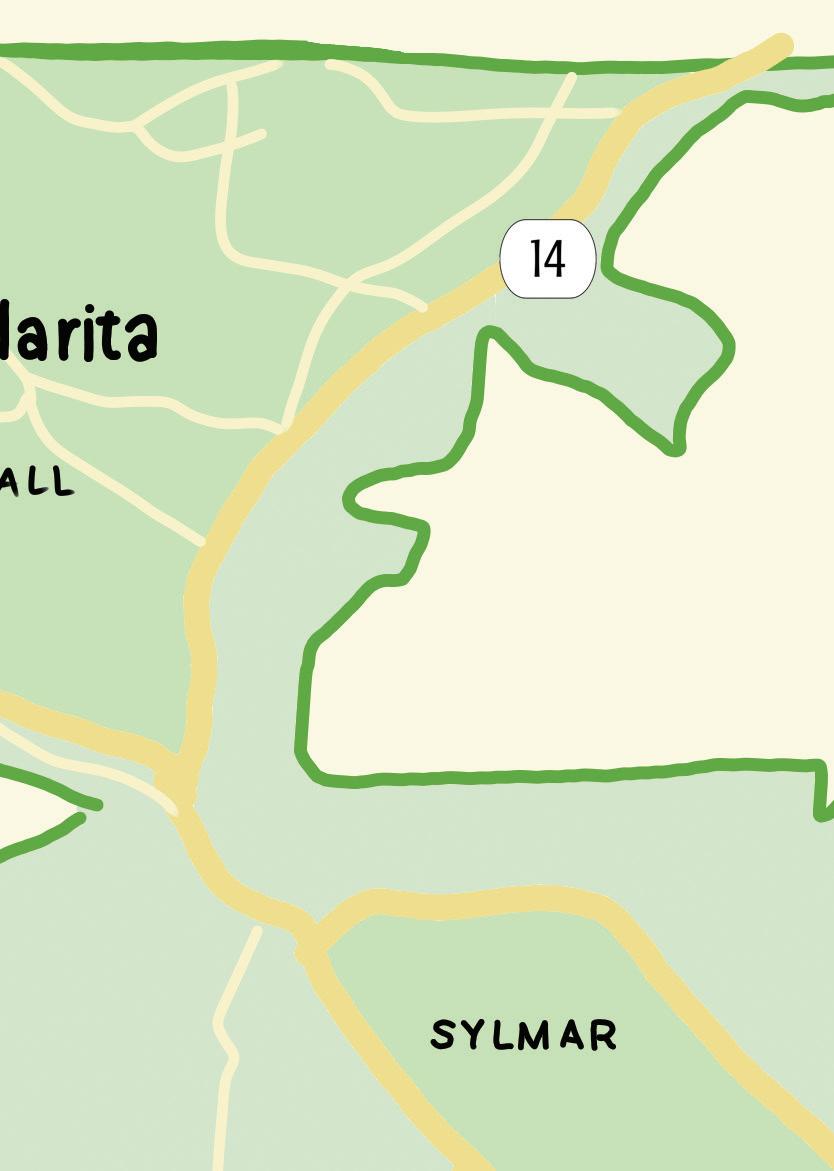
Thursday 4pm-8pm 920 Meridian Ave. South Pasadena SouthPasadenaFarmersMarket.org

11 Monrovia Farmers’ Market Friday 5-9pm South Myrtle Ave.
Monrovia
MonroviaStreetFairMarket.com
Olive View Medical Center Certi ed Farmers’ Market Friday 9am- 2pm 14445 Olive View Dr.
This list was updated December 2022 but as details do change, please contact the markets for the latest information.
If you know of another farmers’ market that is not listed, please let us know at info@ediblesfvalley.com.
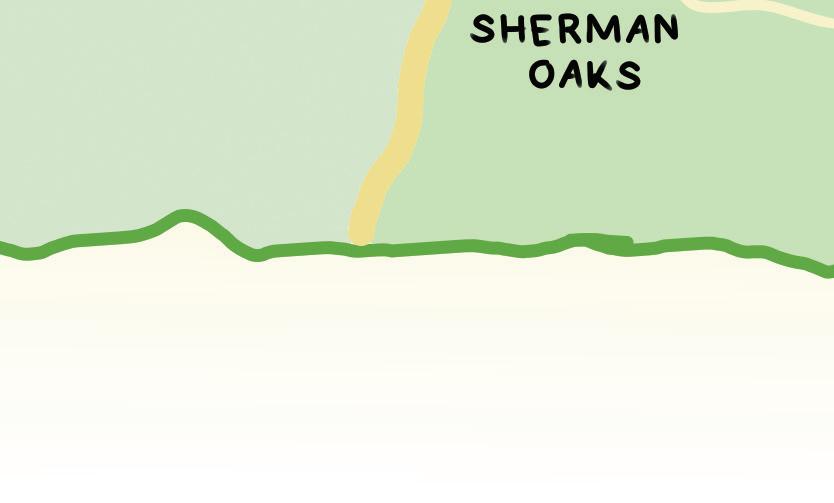

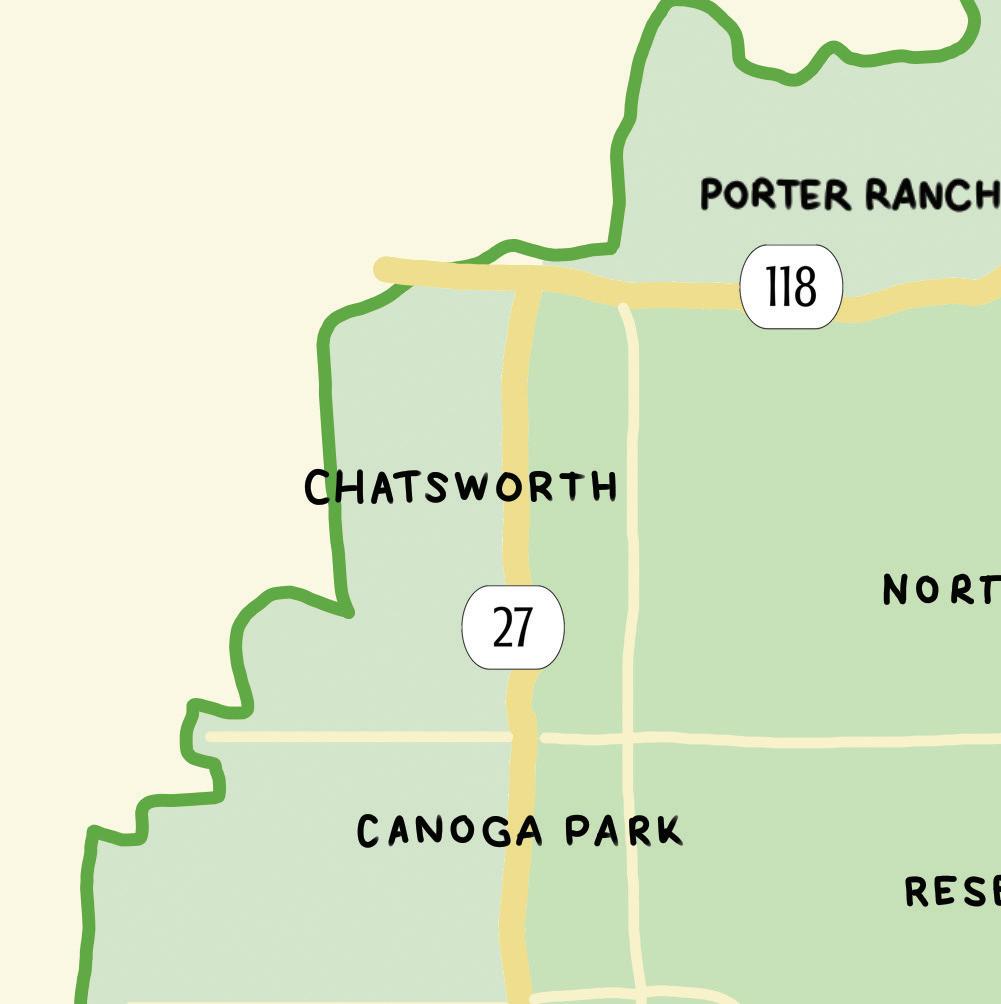


Wednesday 3-8pm Wednesday 4-8pm
Altadena Farmers’ Market 9301 Tampa Ave.
SupportingArms.org/events.html
Reseda Farmers’ Market 8500 Reseda Blvd.
Sylmar Friday 4-8pm Reseda @ccfminc
Warner Center Farmers’ Market Friday 10am-2pm 21255 Burbank Blvd. Woodland Hills RawInspiration.org
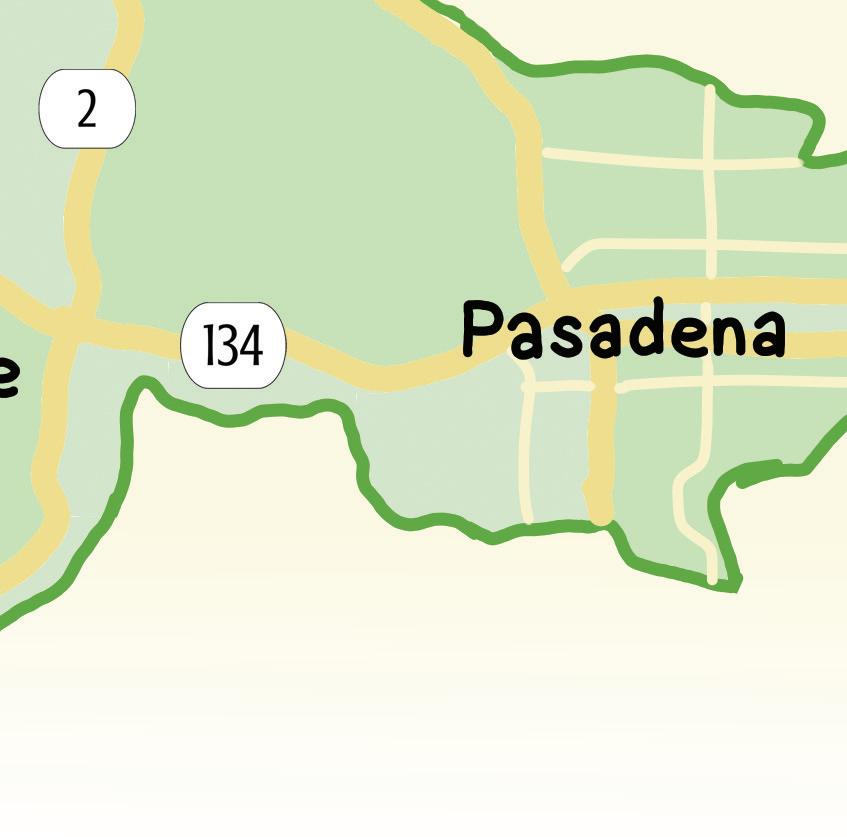
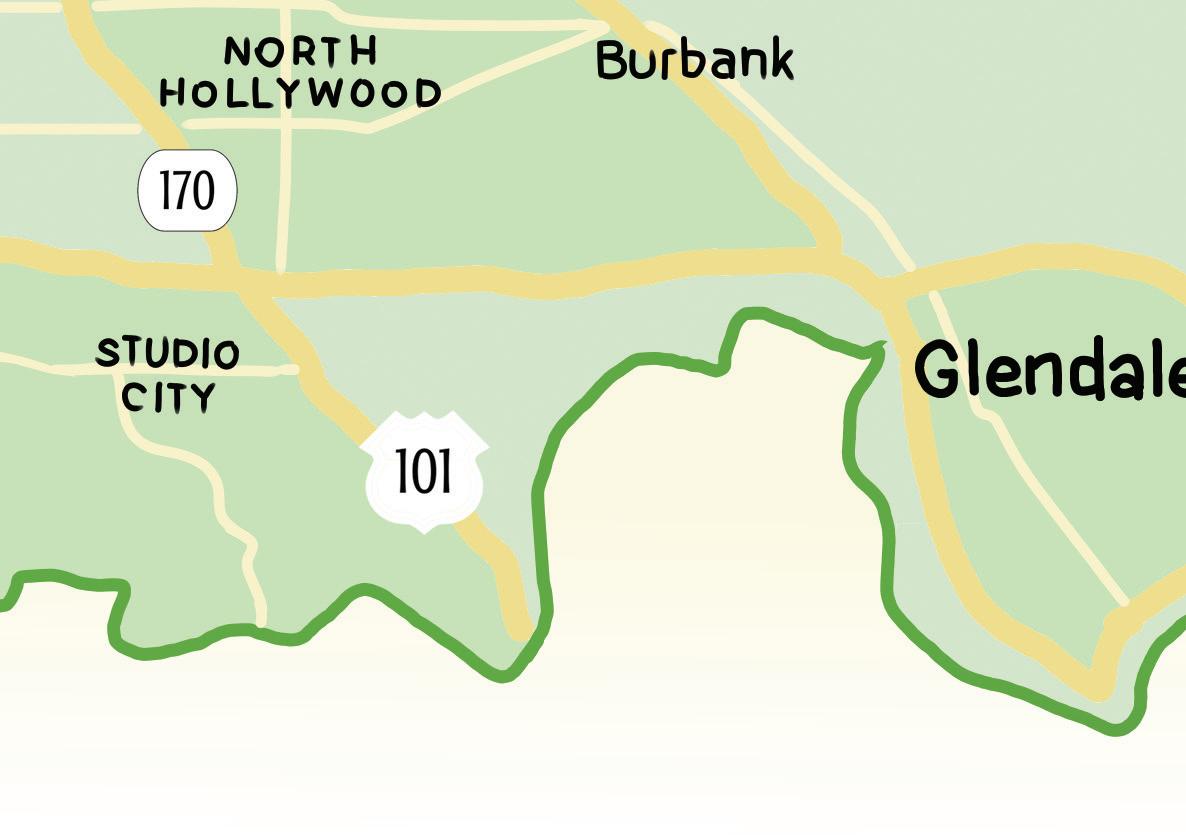


15 Agoura Hills Farmers’ Market





at Whizen Market Square
Saturday 11am-4pm 28914 Roadside Dr. Agoura Hills RawInspiration.org

16 Burbank Farmers’ Market
Saturday 8am-12pm 101 N. Glenoaks Blvd.
Burbank BurbankFarmersMarket.org
Market
Saturday 9am-1:30pm 7248 Owensmouth Ave. Canoga Park CoastalPaci cMarkets.com
Farmers Market
Saturdays 9am- 1pm 1346 Foothill Blvd. La Cañada Flintridge RawInspiration.org




19 NoHo Farmers’ Market
Saturday 9:30am- 2:30pm 5000 Colfax North Hollywood FarmersMarketNorthHollywood.com
20 Old Town Calabasas
Farmers’ Market
Saturday 8am-1pm 23504 Calabasas Rd. Calabasas CCFM.com
Old Town Newhall Farmers’ Market Saturday 8:30am-1pm
24500 Main St. Santa Clarita
NewhallFarmersMarket.com
Pasadena Victory Park Farmers’ Market
Saturday 8am-12:30pm 2925 E. Sierra Madre Blvd.
24 Atwater Village Farmers’ Market
Saturday 9am-2pm 3528 Larga Ave. Atwater Village SeeLA.org/markets-atwater-village
25 Encino Farmers’ Market
Sunday 8am-1pm 17400 Victory Blvd. Van Nuys
2300-2314 Honolulu Ave.
ShopMontrose.com/harvest-market-and-marketplace
Santa Clarita Certi ed Farmers’ Market


Sunday 8am-noon
31 Forneris Farms 15200 Rinaldi St. Mission Hills FornerisFarms.com
*Closed January and February
32 Sanchez Produce 16230 Sierra Hwy. Santa Clarita
@Sanchezproduce
5251 Havenhurst Ave. Encino @tapiabrosfarm
*Closed January and February


South Central Farmers CSA Various pickup and delivery options SCFCoop.SouthCentralFarmers.com
PasadenaFarmersMarket.org
Woodland Hills Farmers’ Market
Saturday 8am-1pm 5650 Shoup Ave.
Pasadena Woodland Hills 818-300-3023
Valencia Blvd. & Rockwell Canyon Rd.
StudioCityFarmersMarket.com

North Hollywood
Sunday 10am-2pm
Electrical outlet on farmstand booth
9. Golf clubs; 10. Man spraying pesticides; 11. Fish on register; 12. Rubber duck on vegetables; 13.



3. Hamburger grill; 4. Grandma knitting in rocking chair; 5. Owl; 6. Lion; 7. Robot; 8. Boy in ski gear;
Answers (page 40 from top): 1. Lamp with purple shade; 2. Boy watching TV

